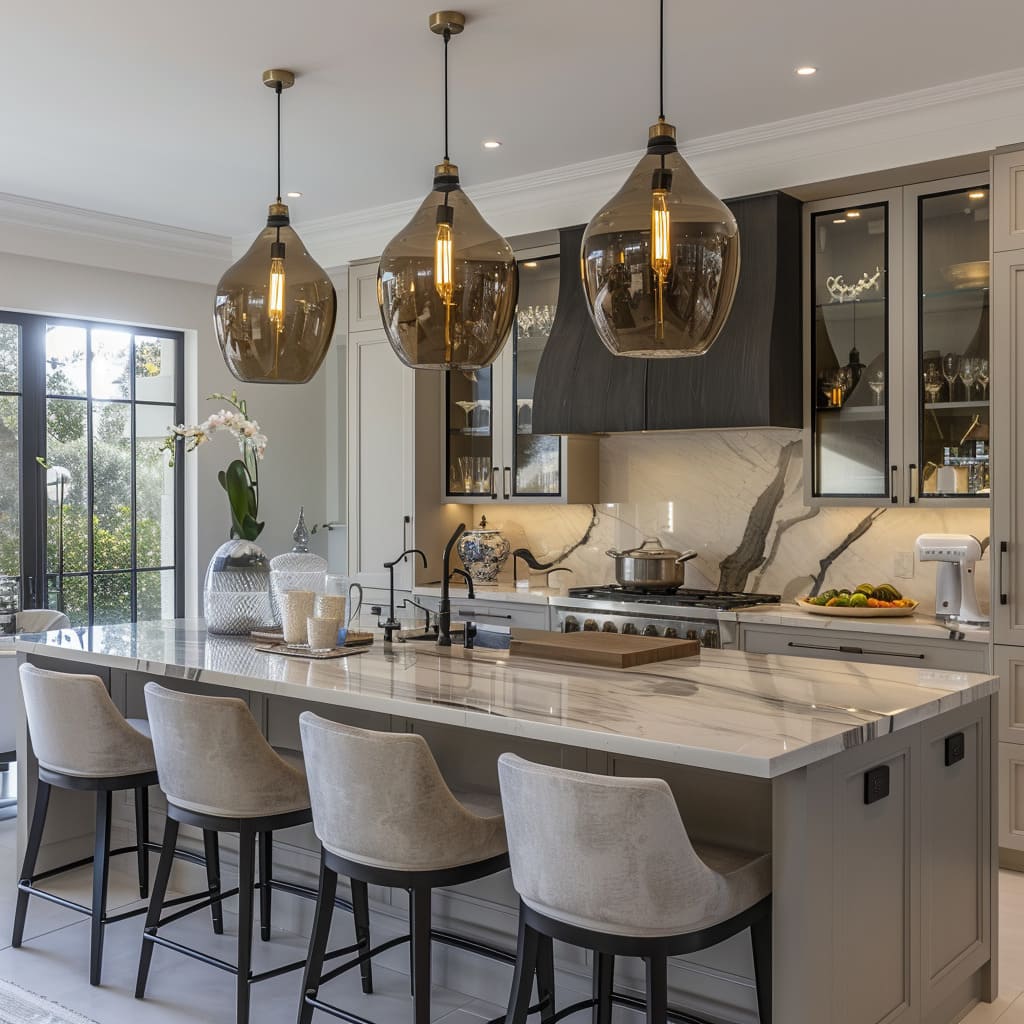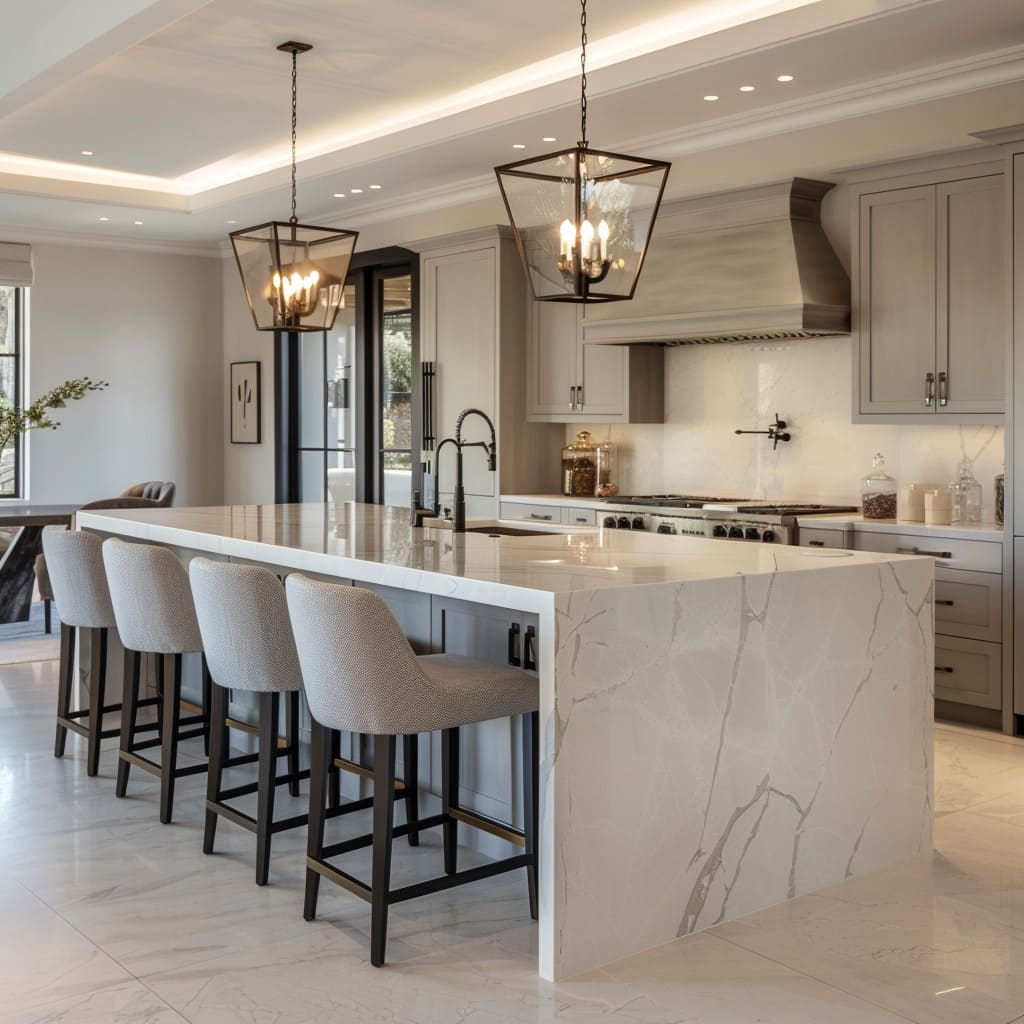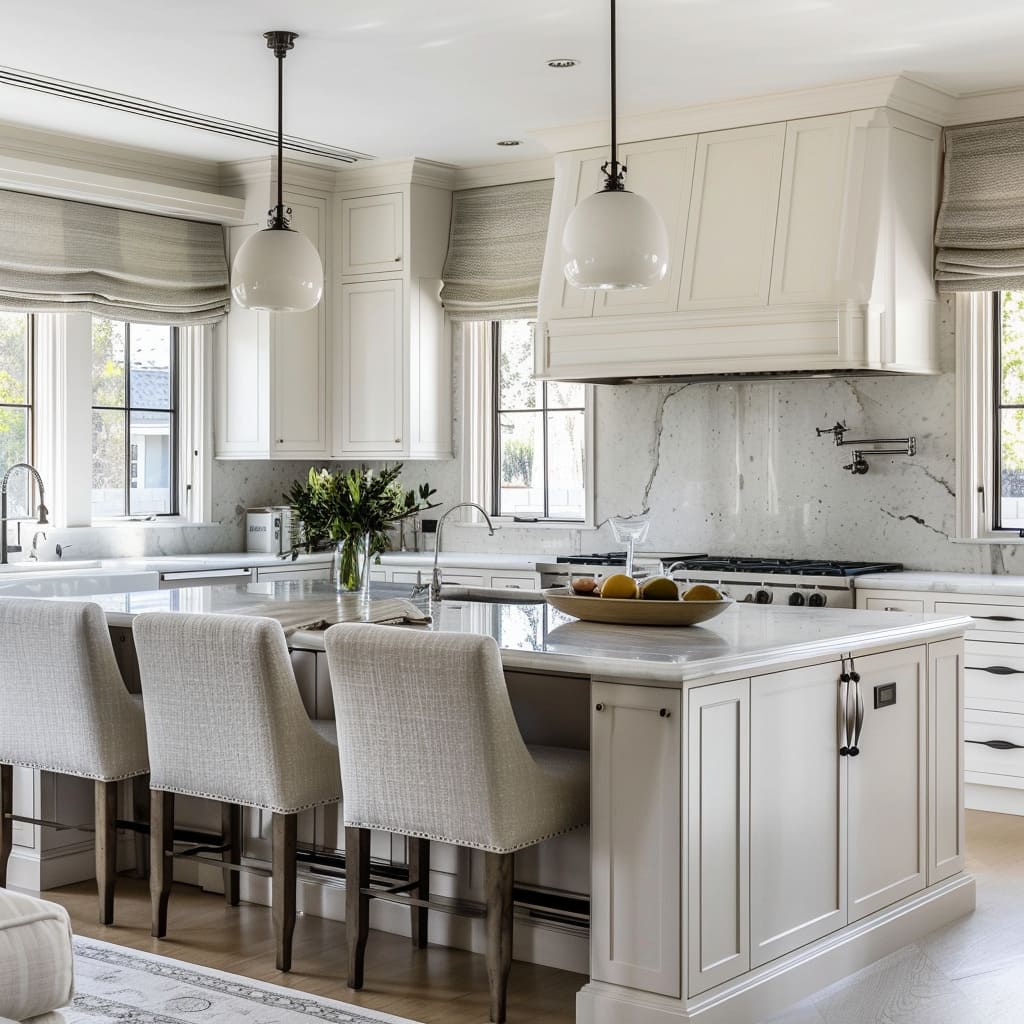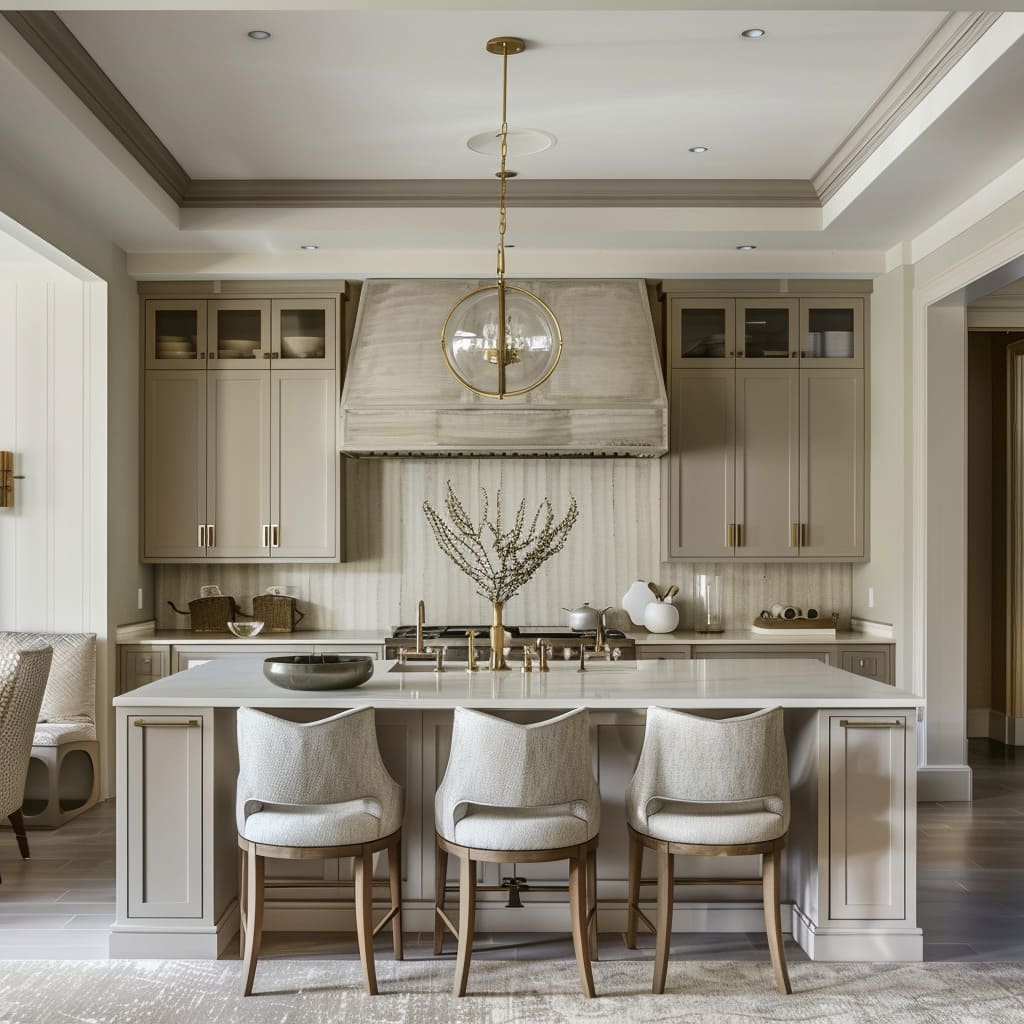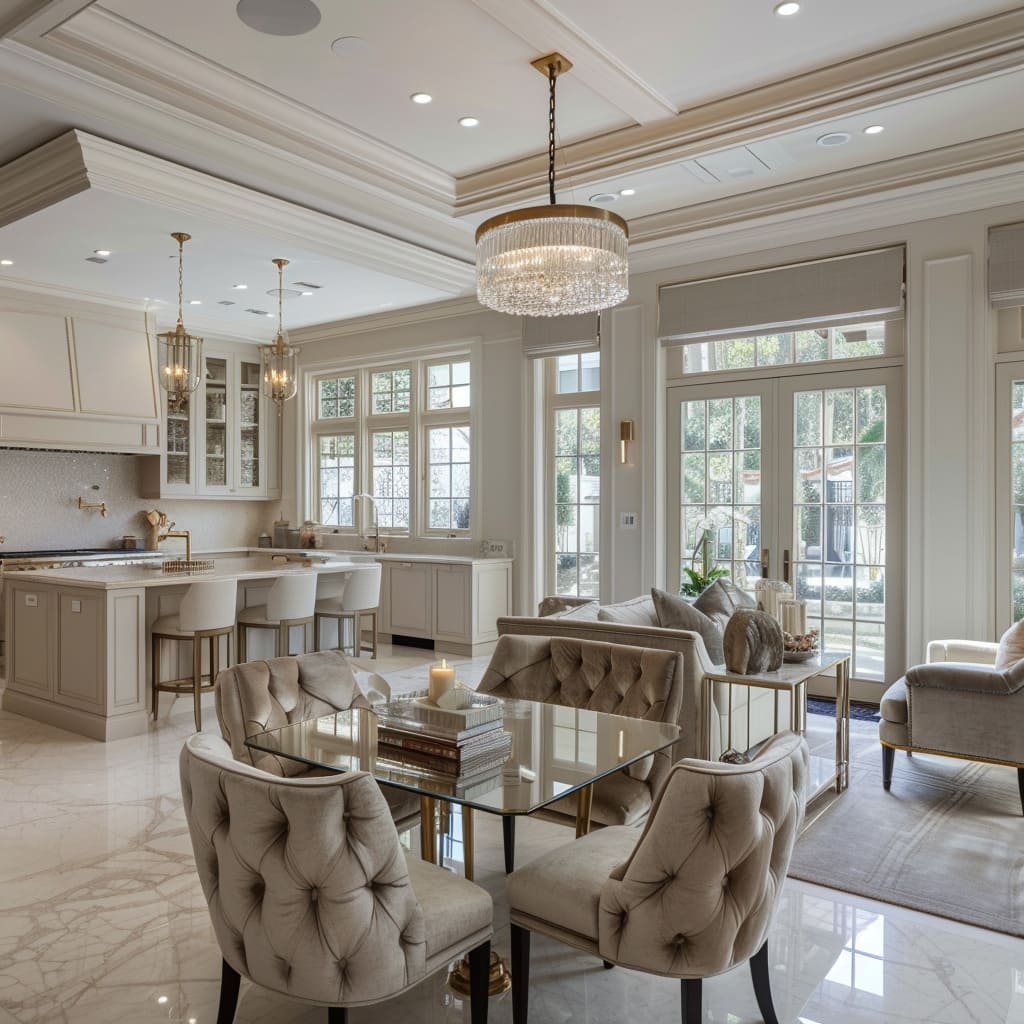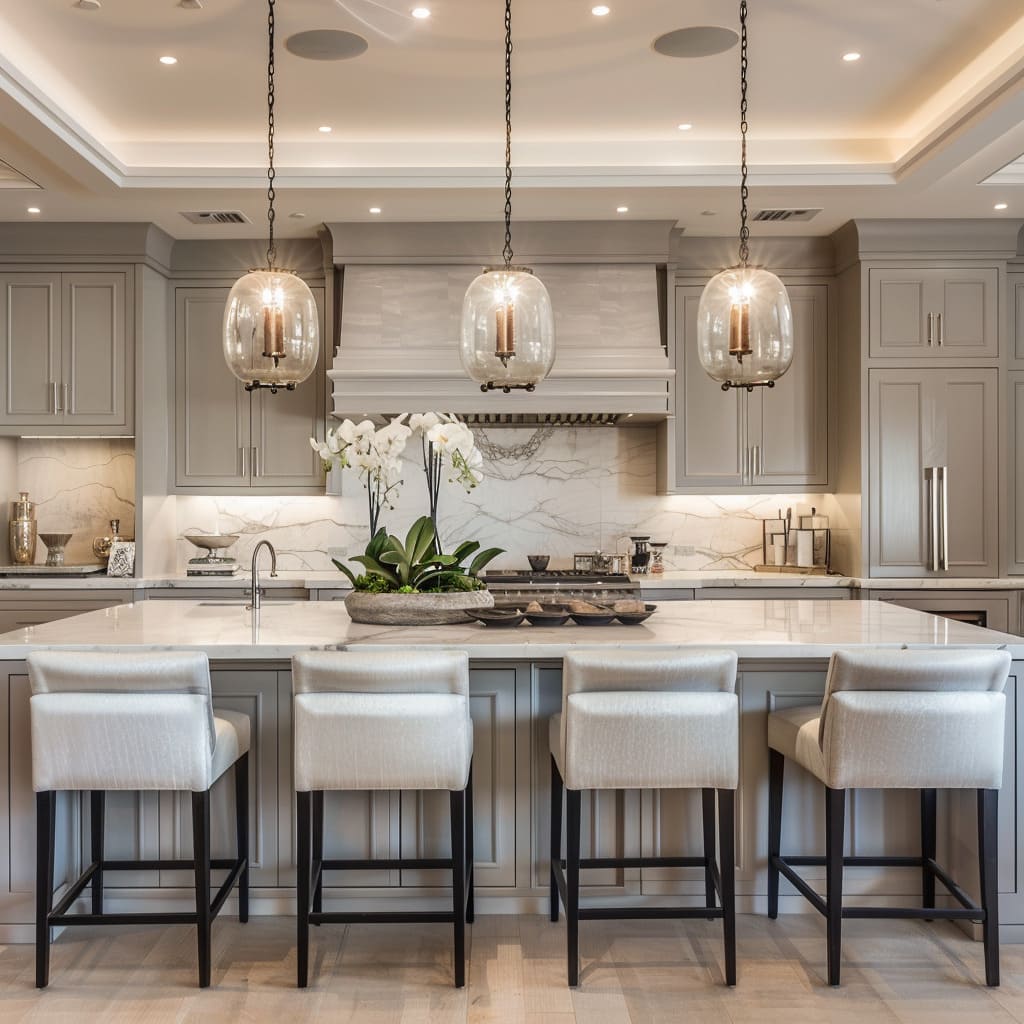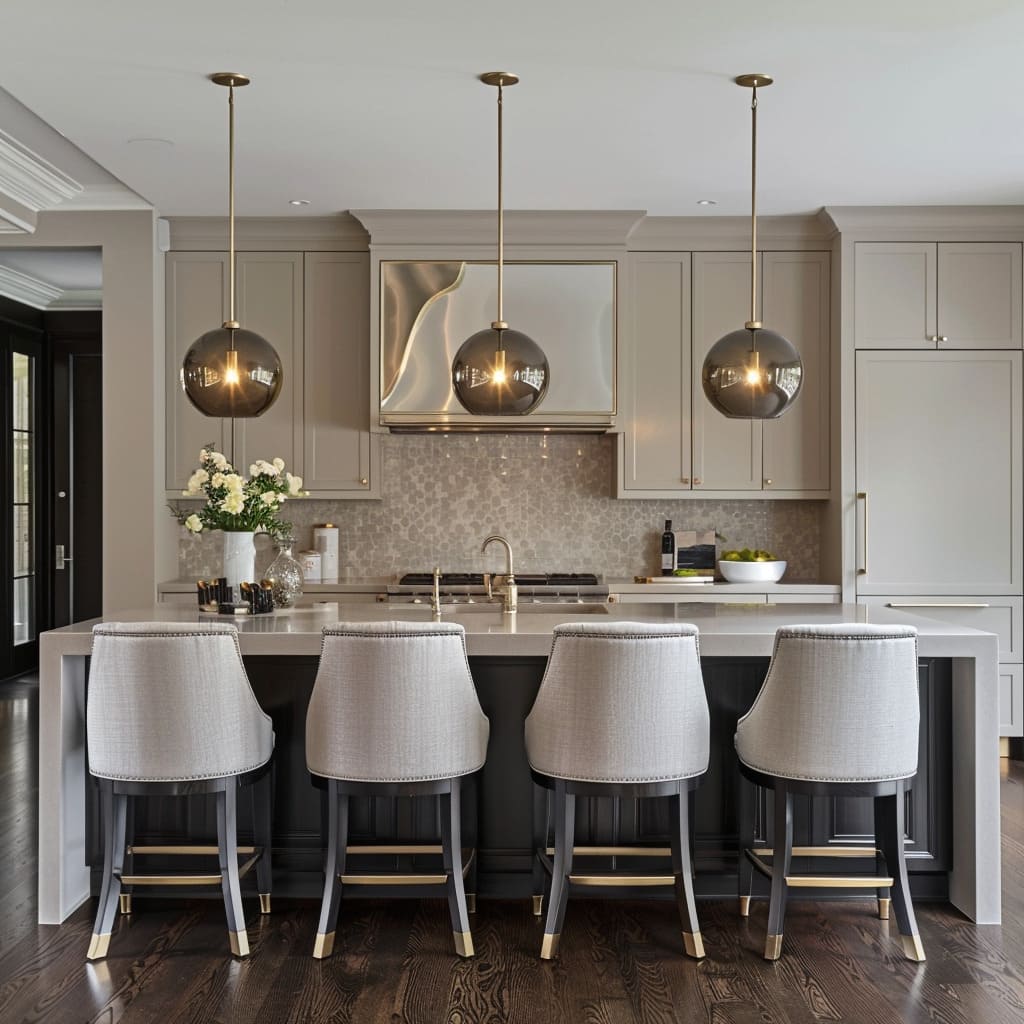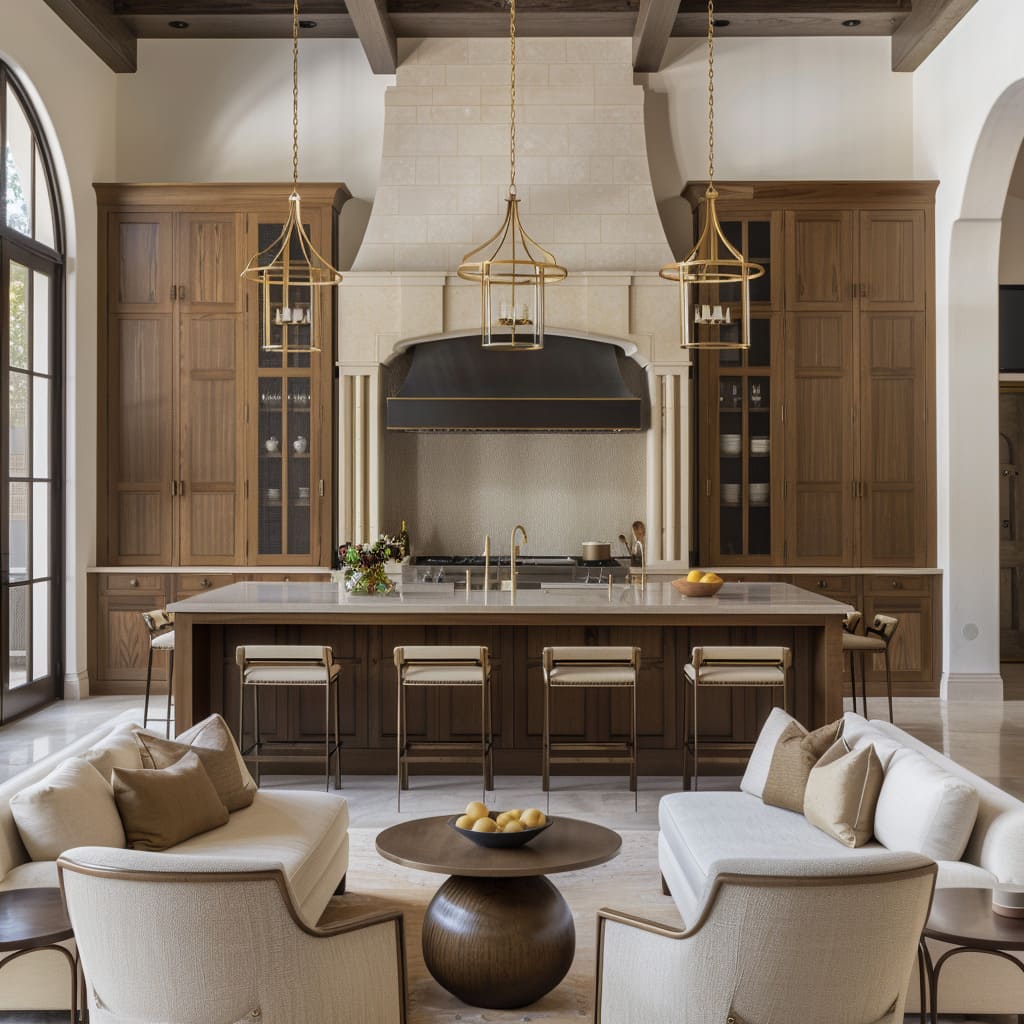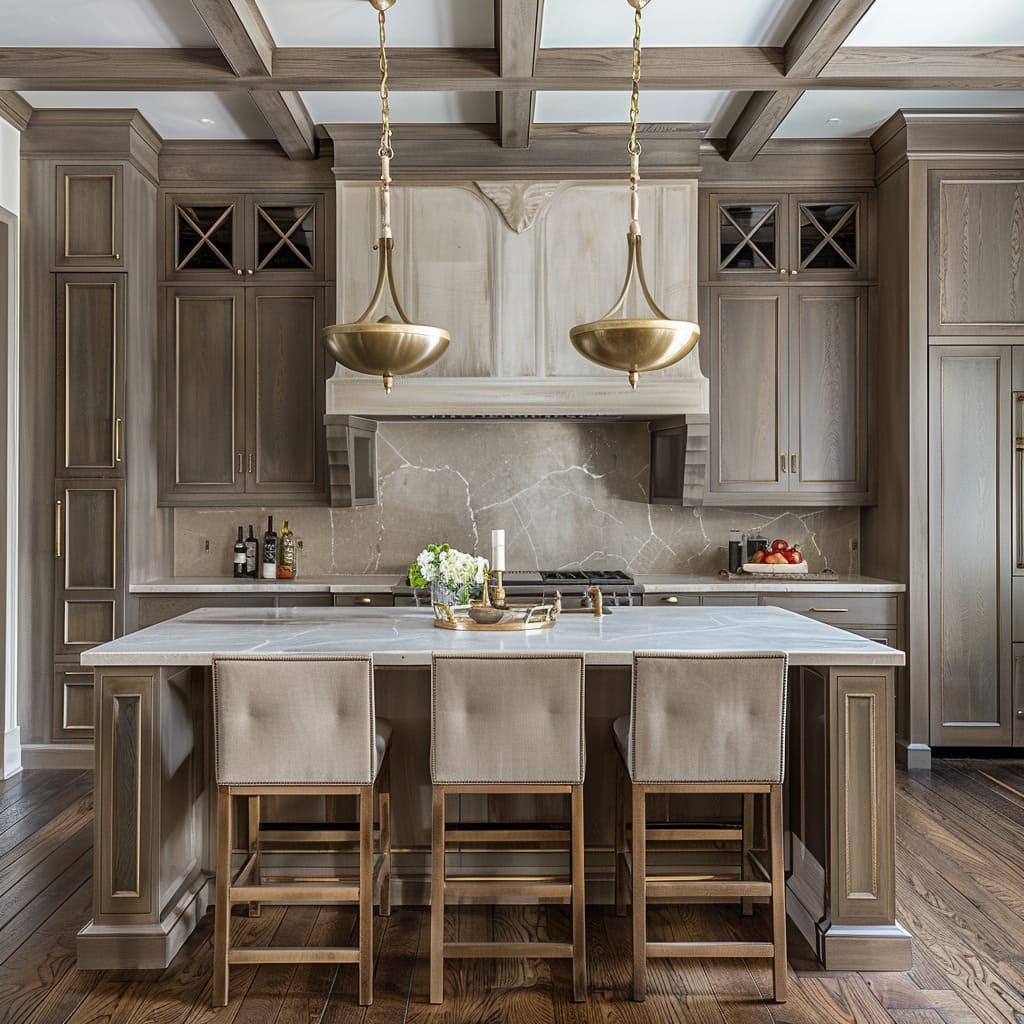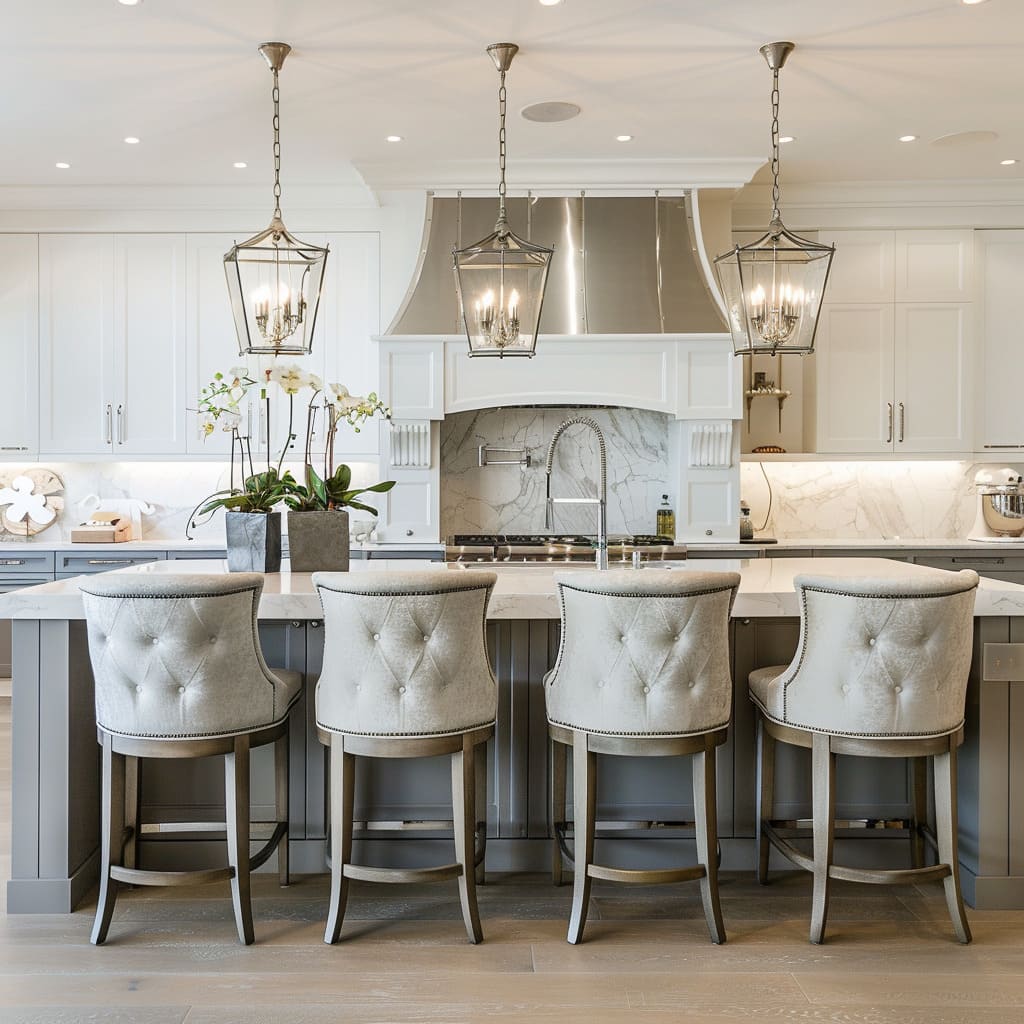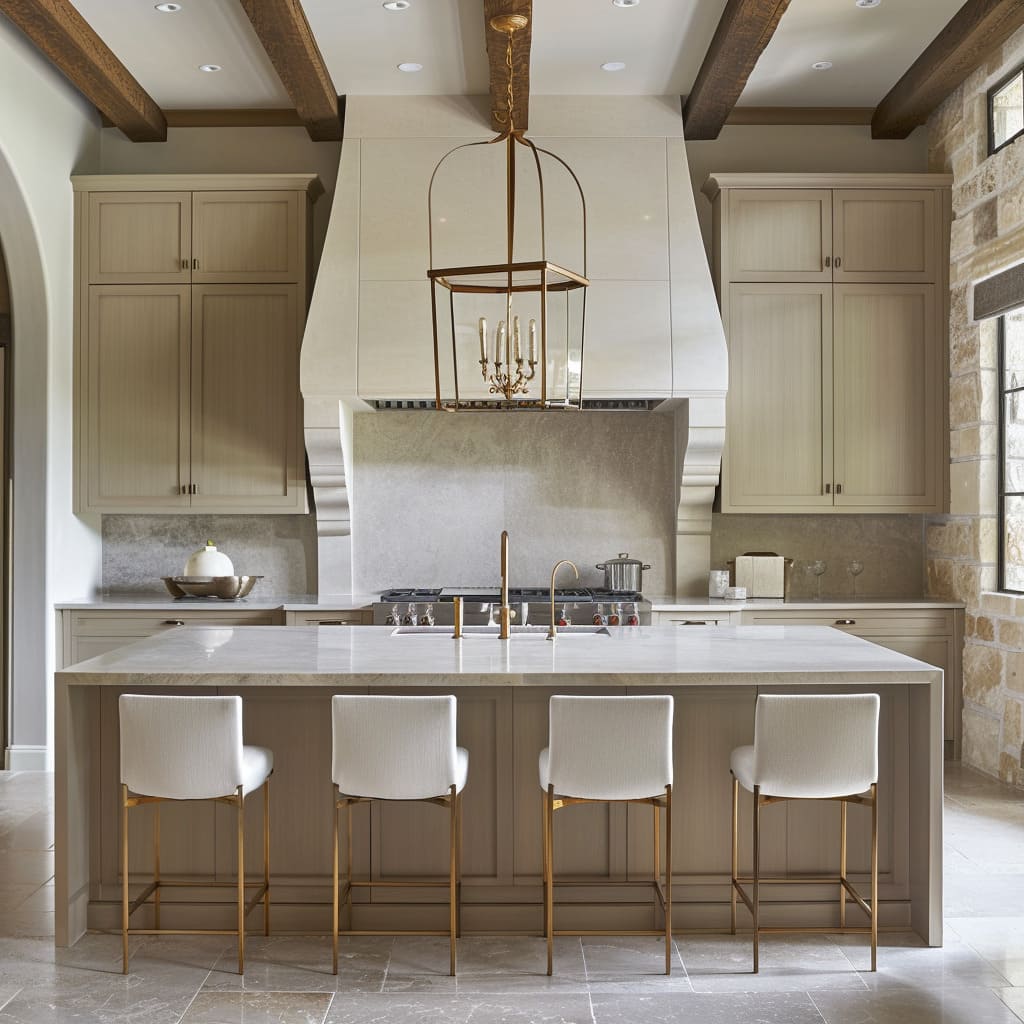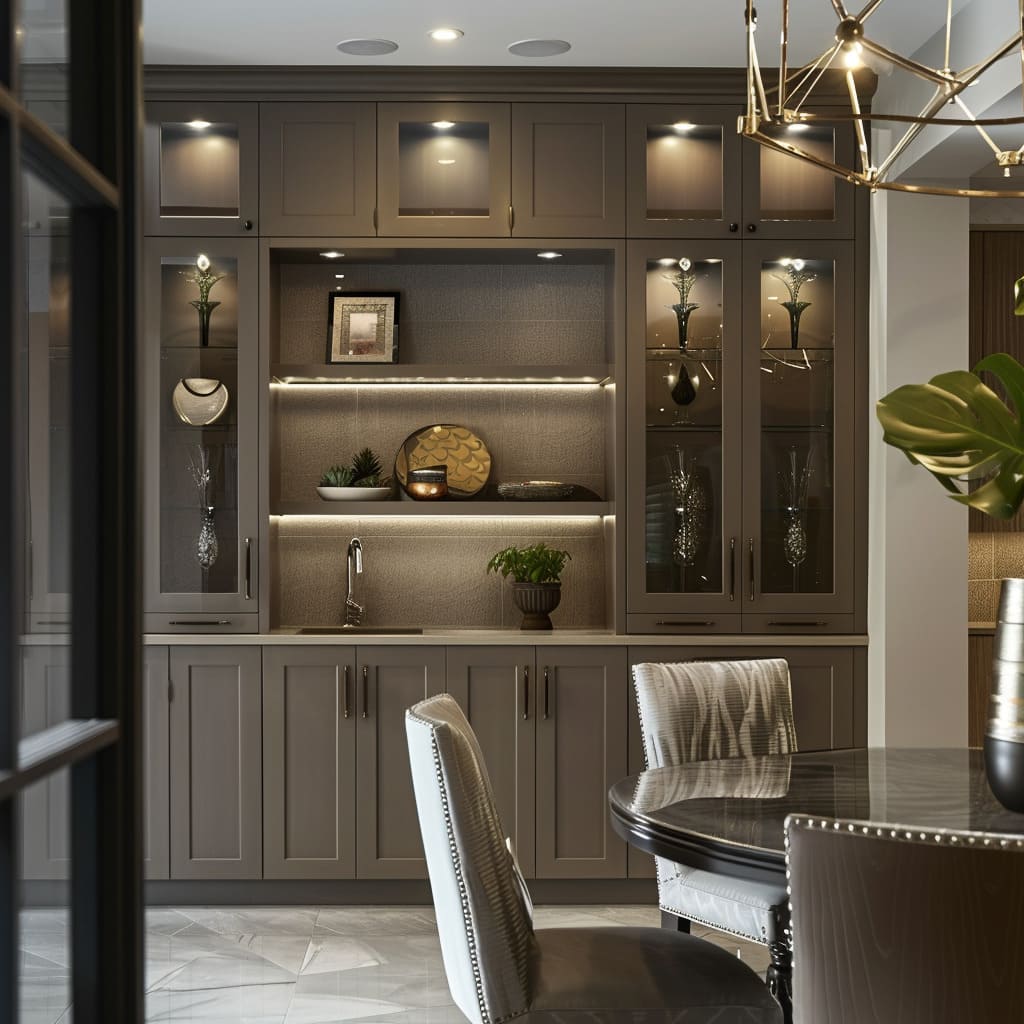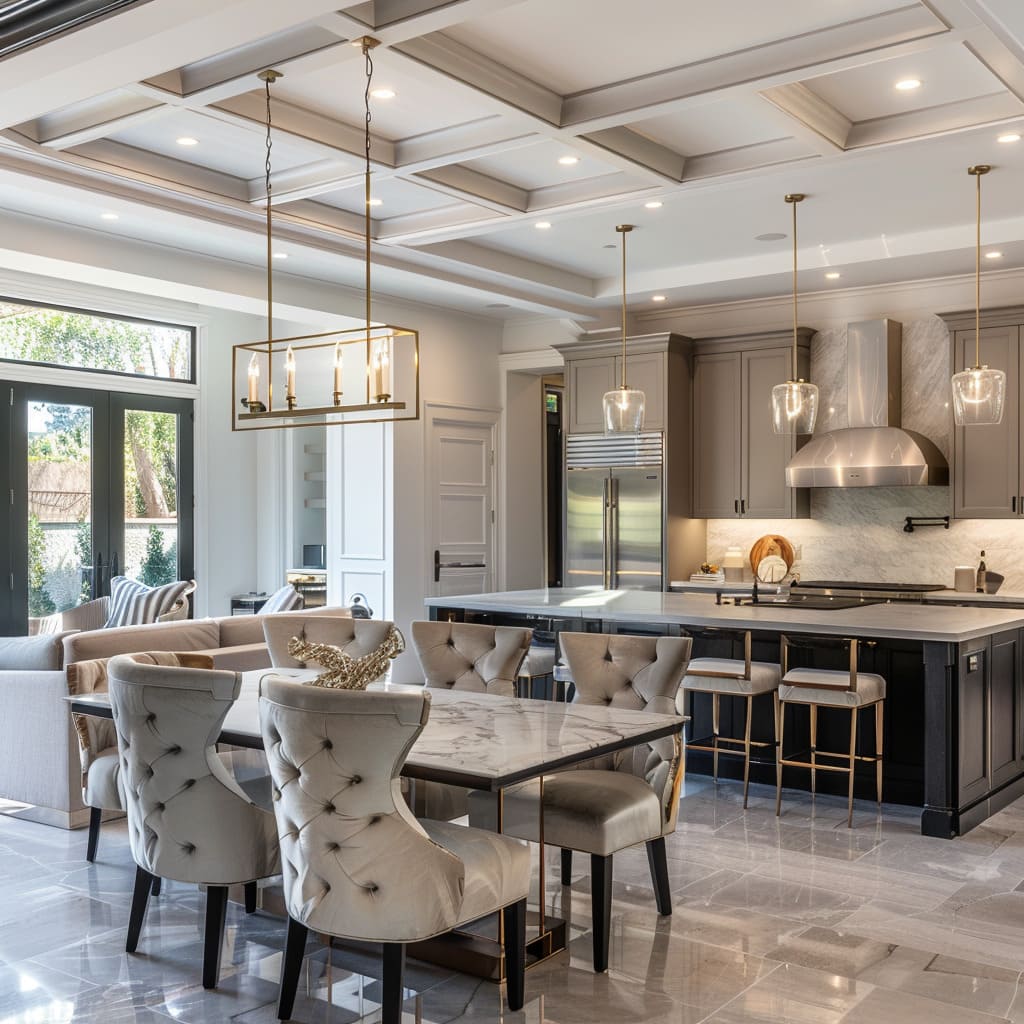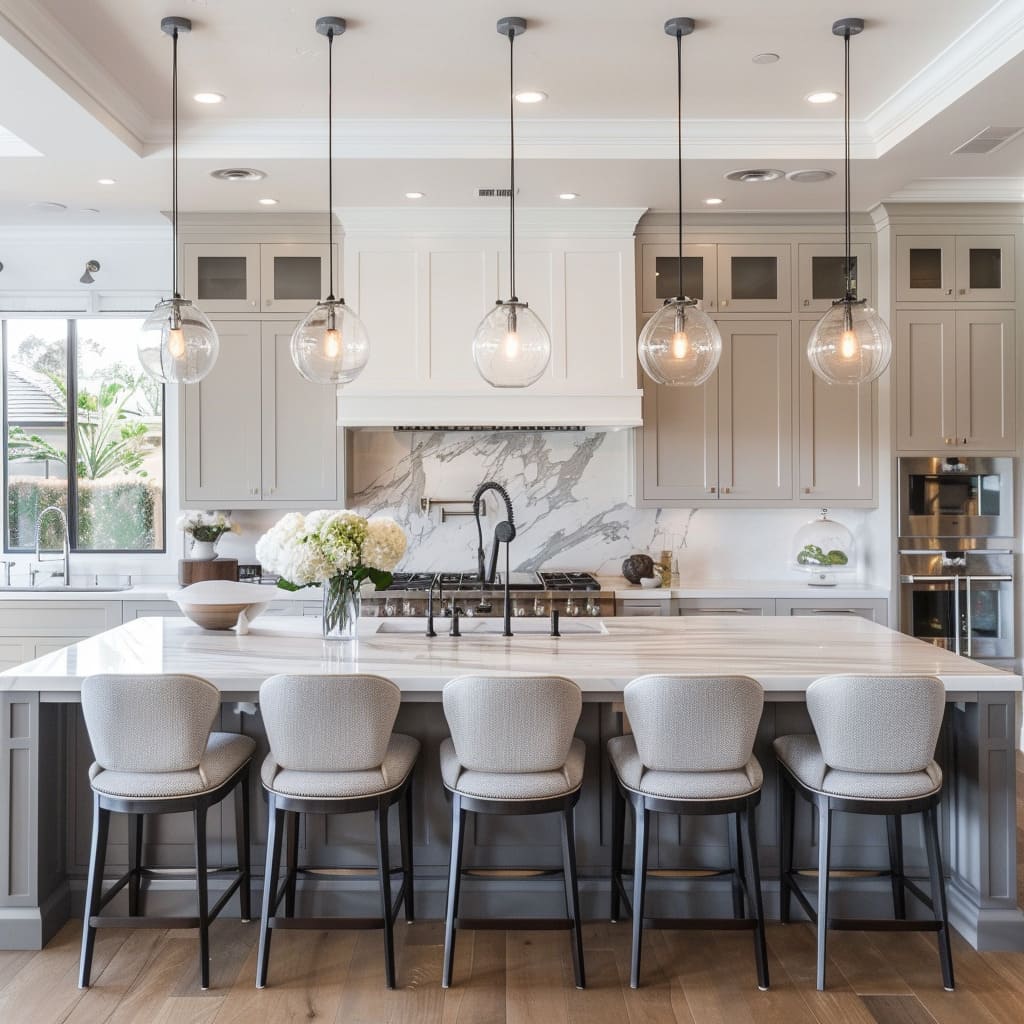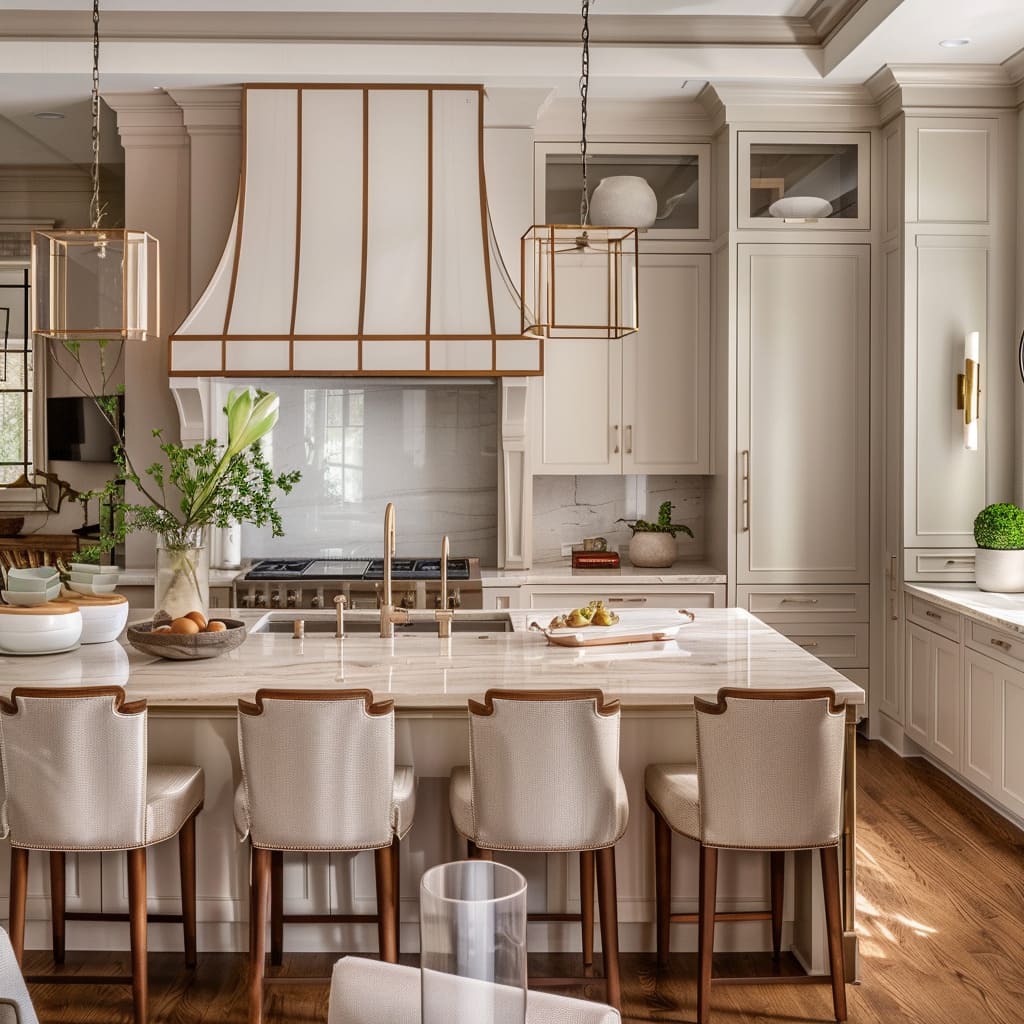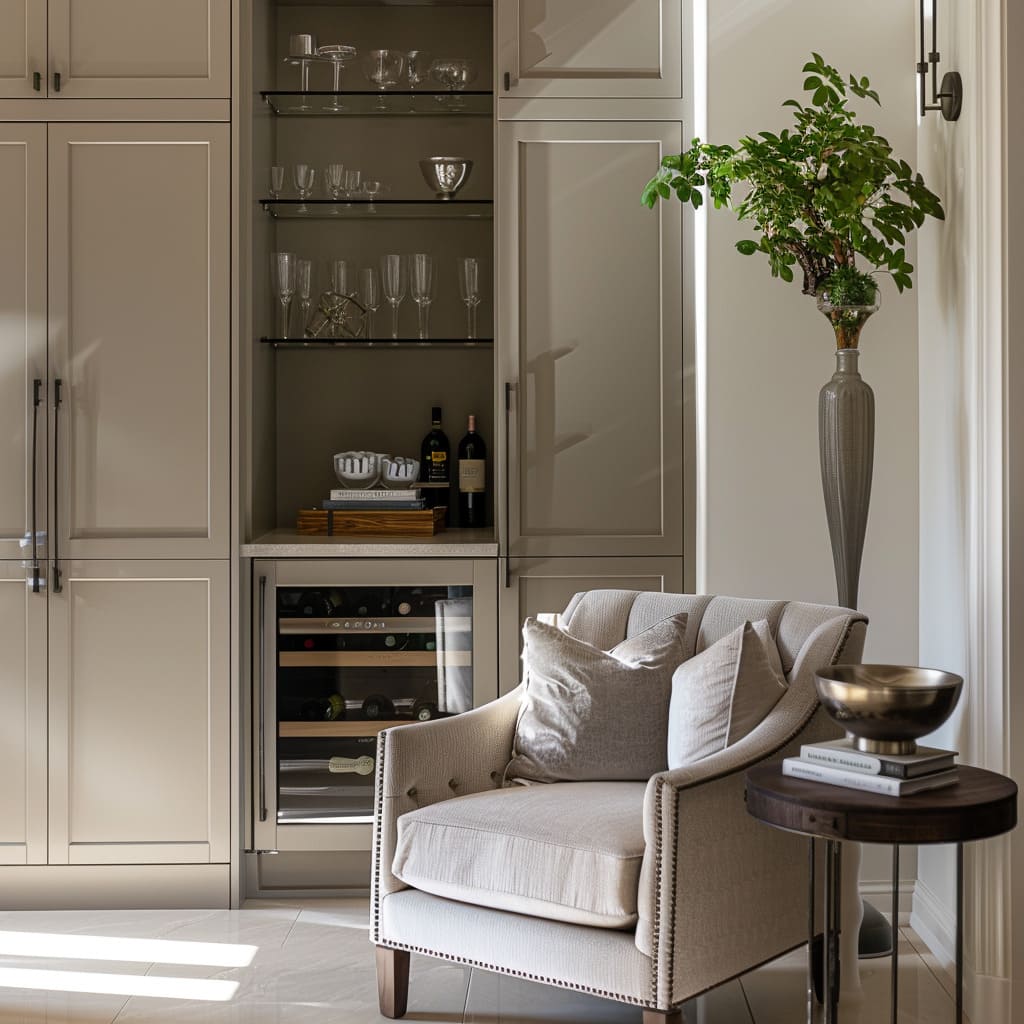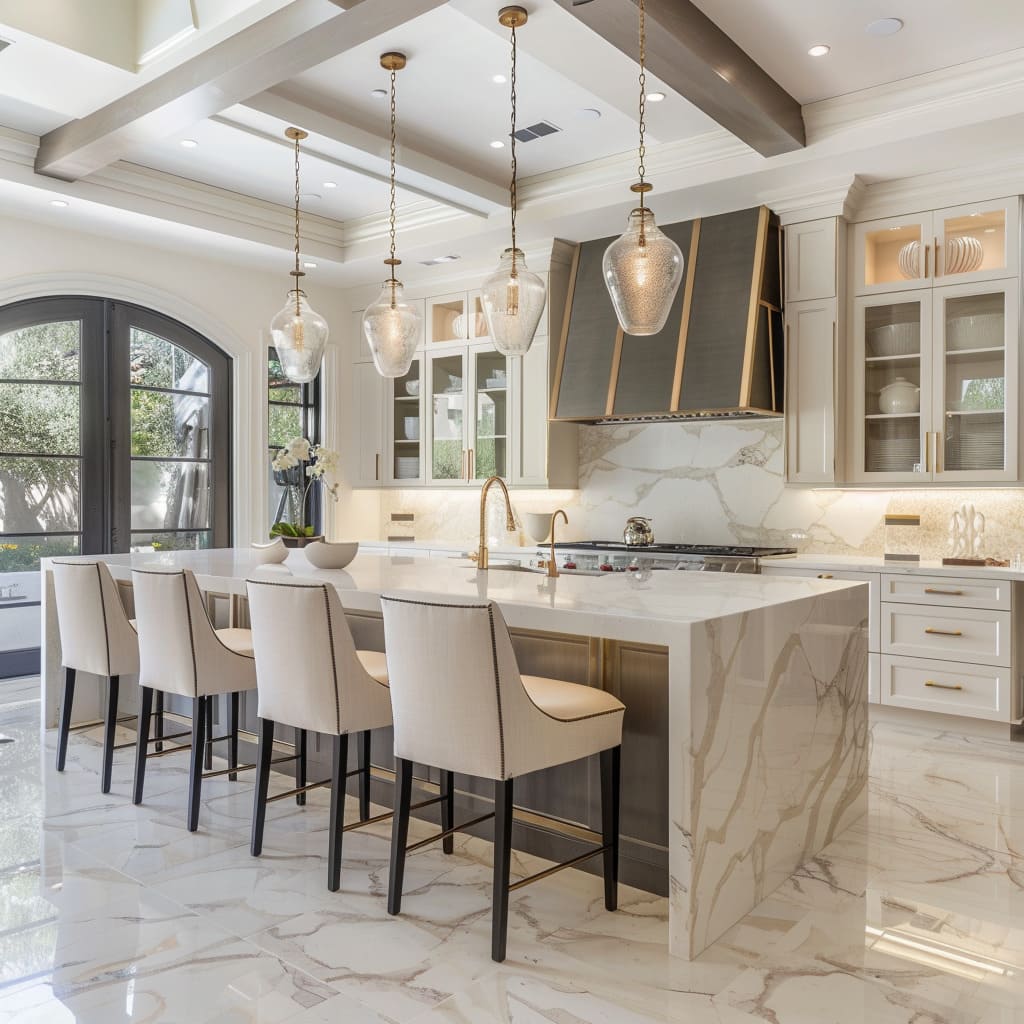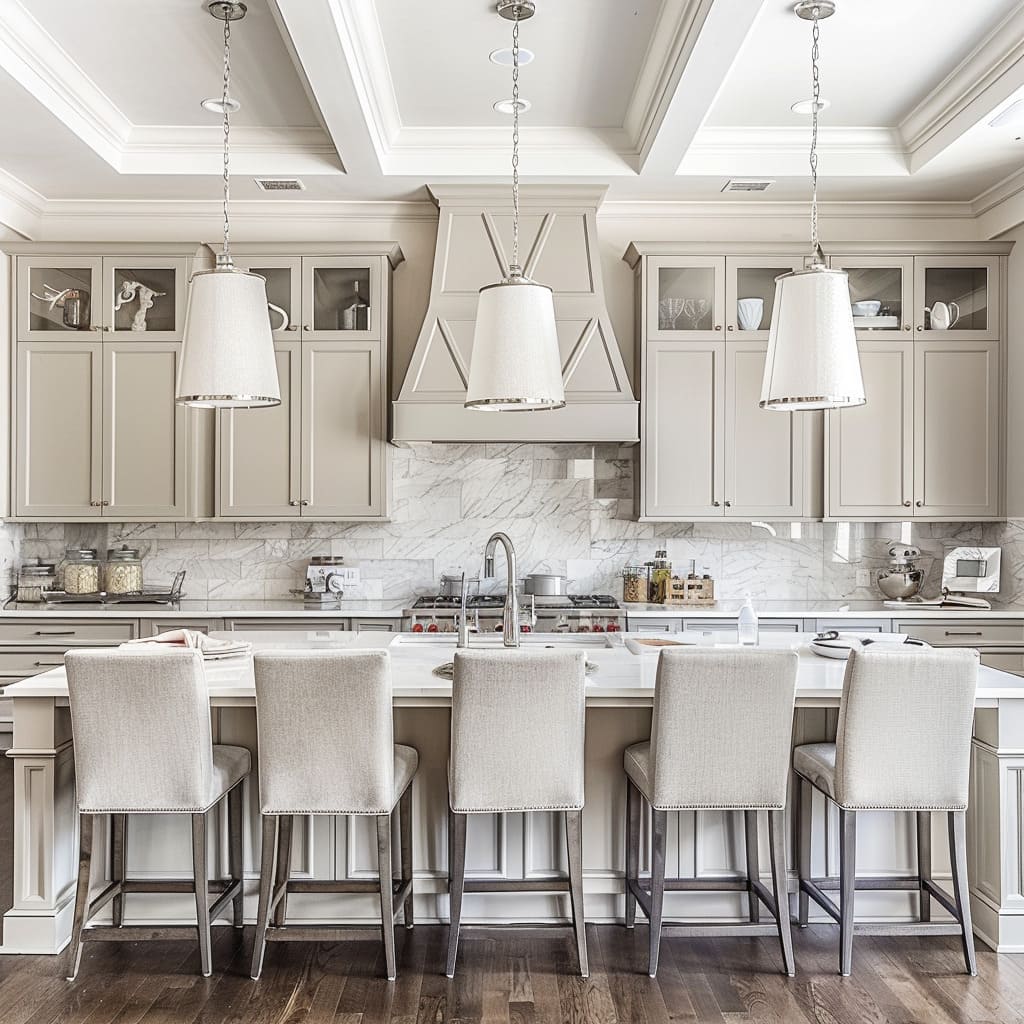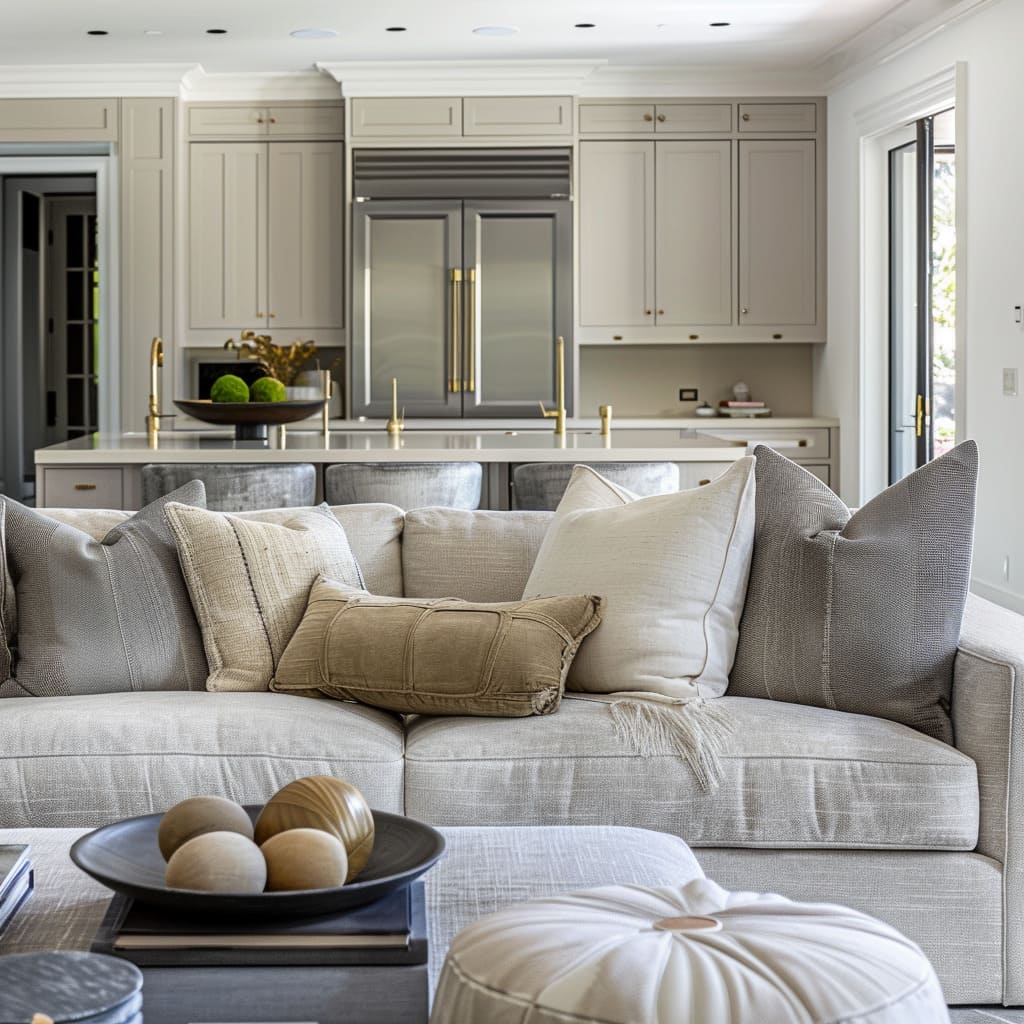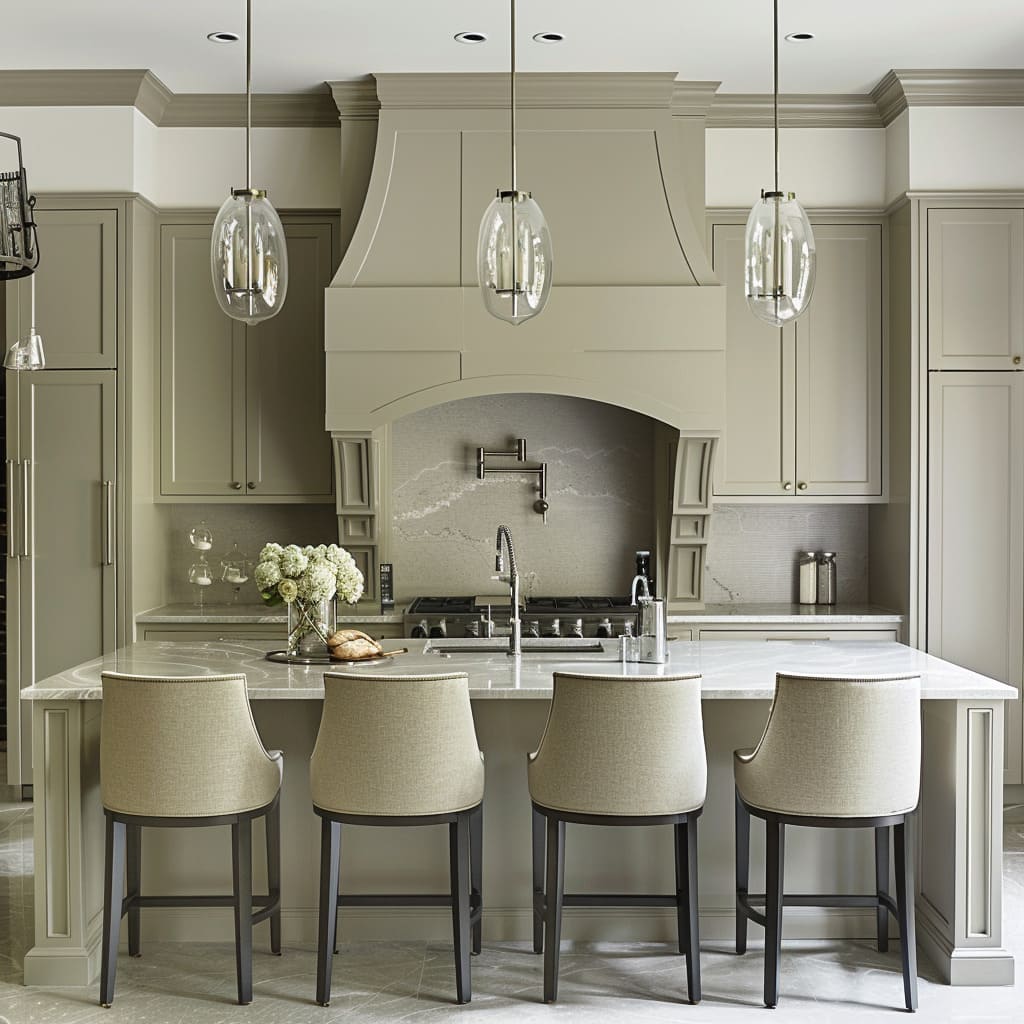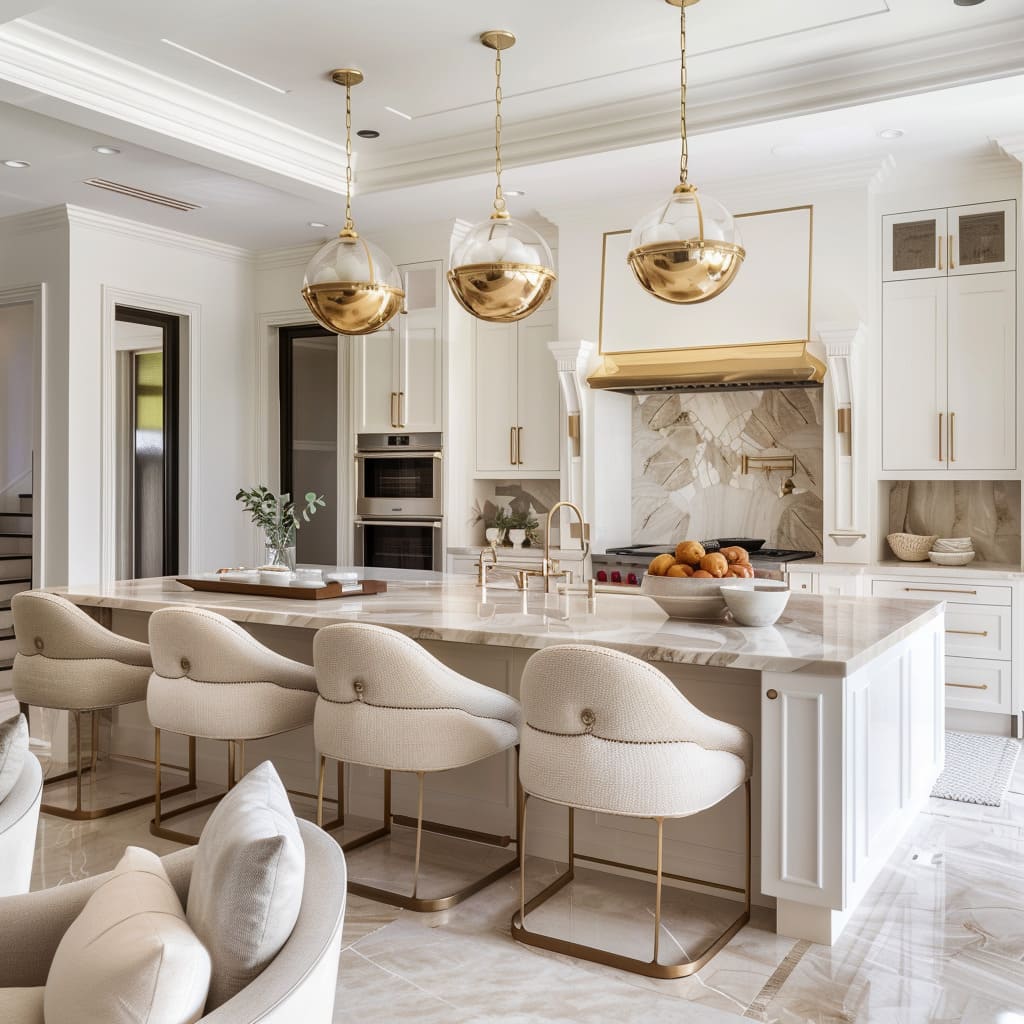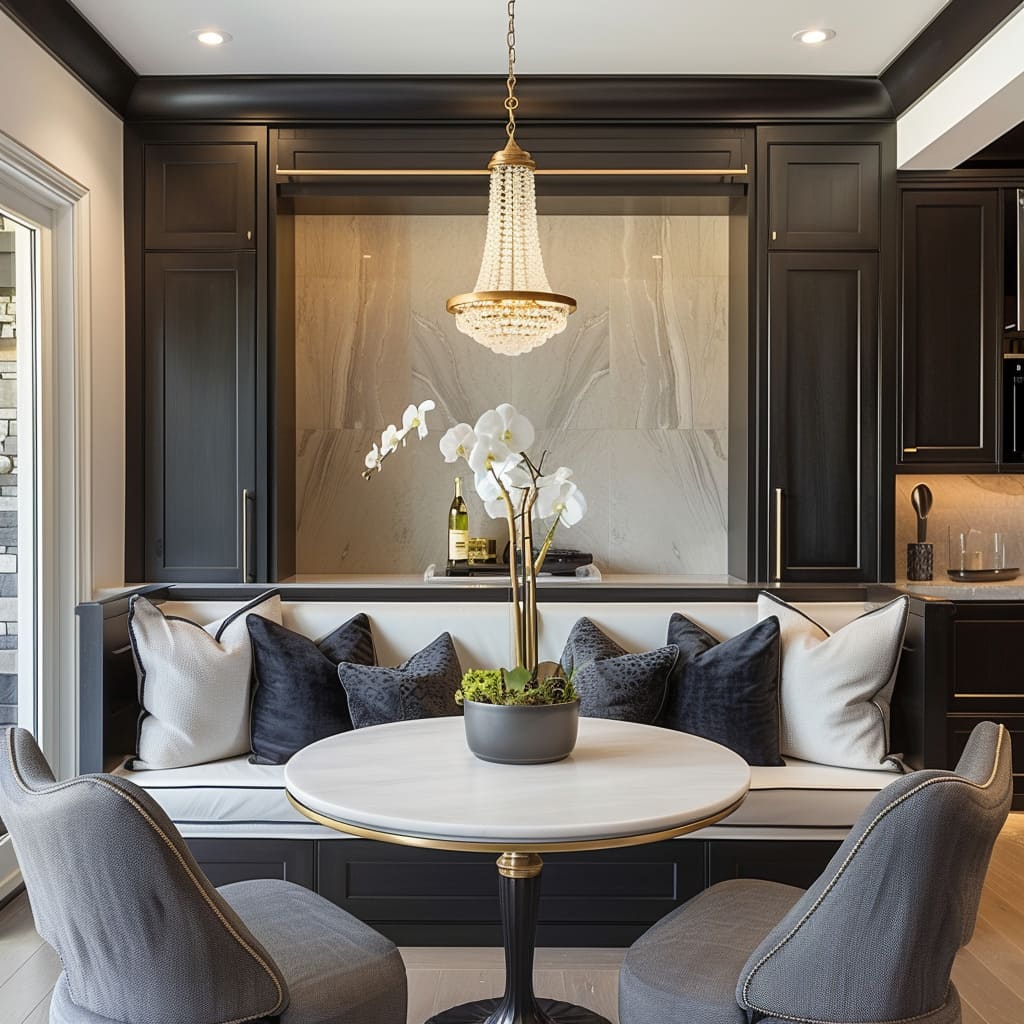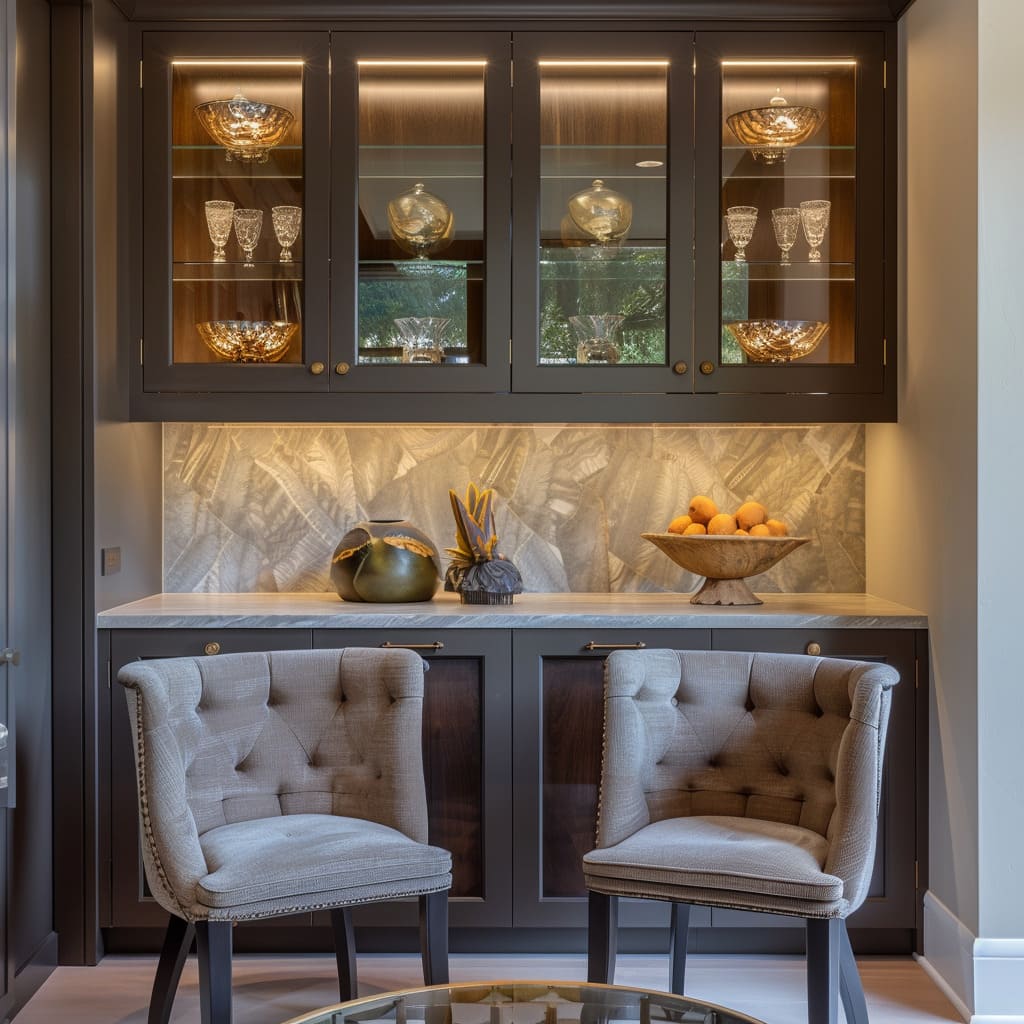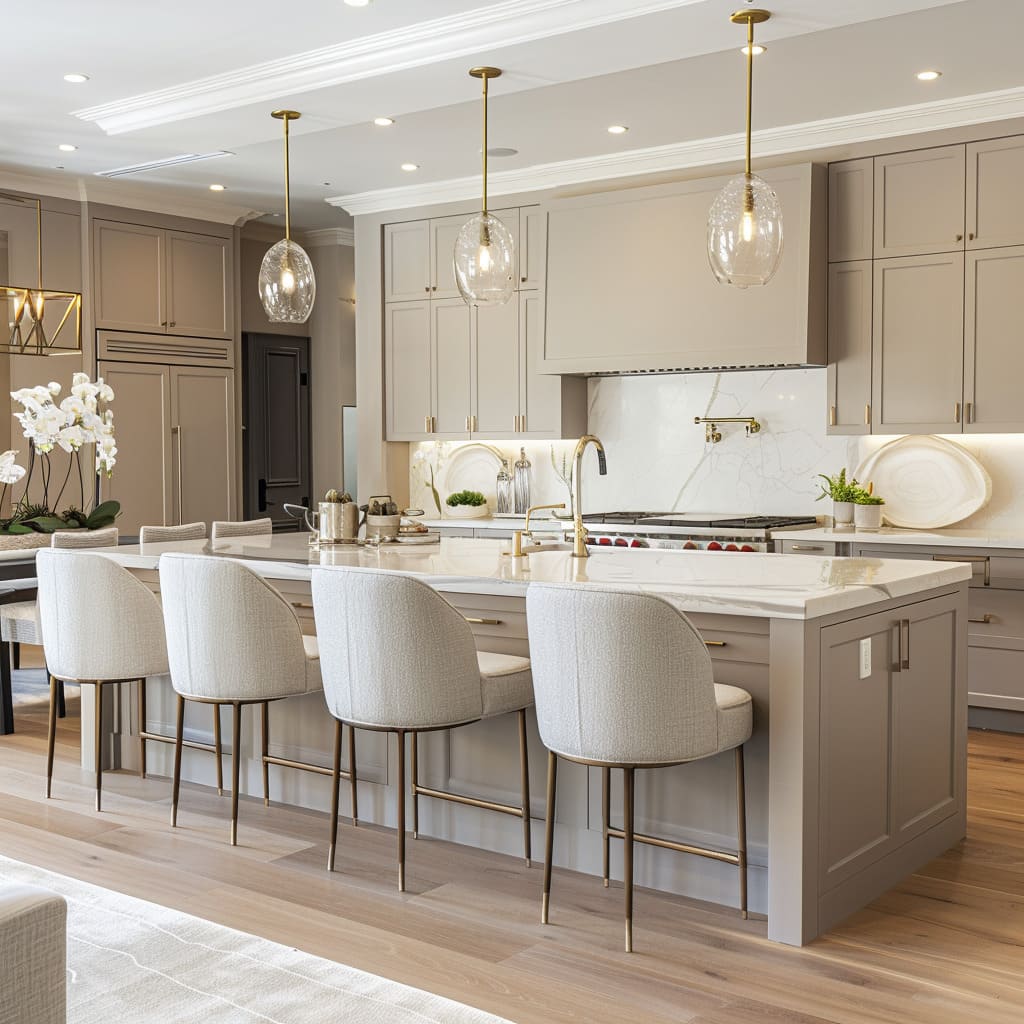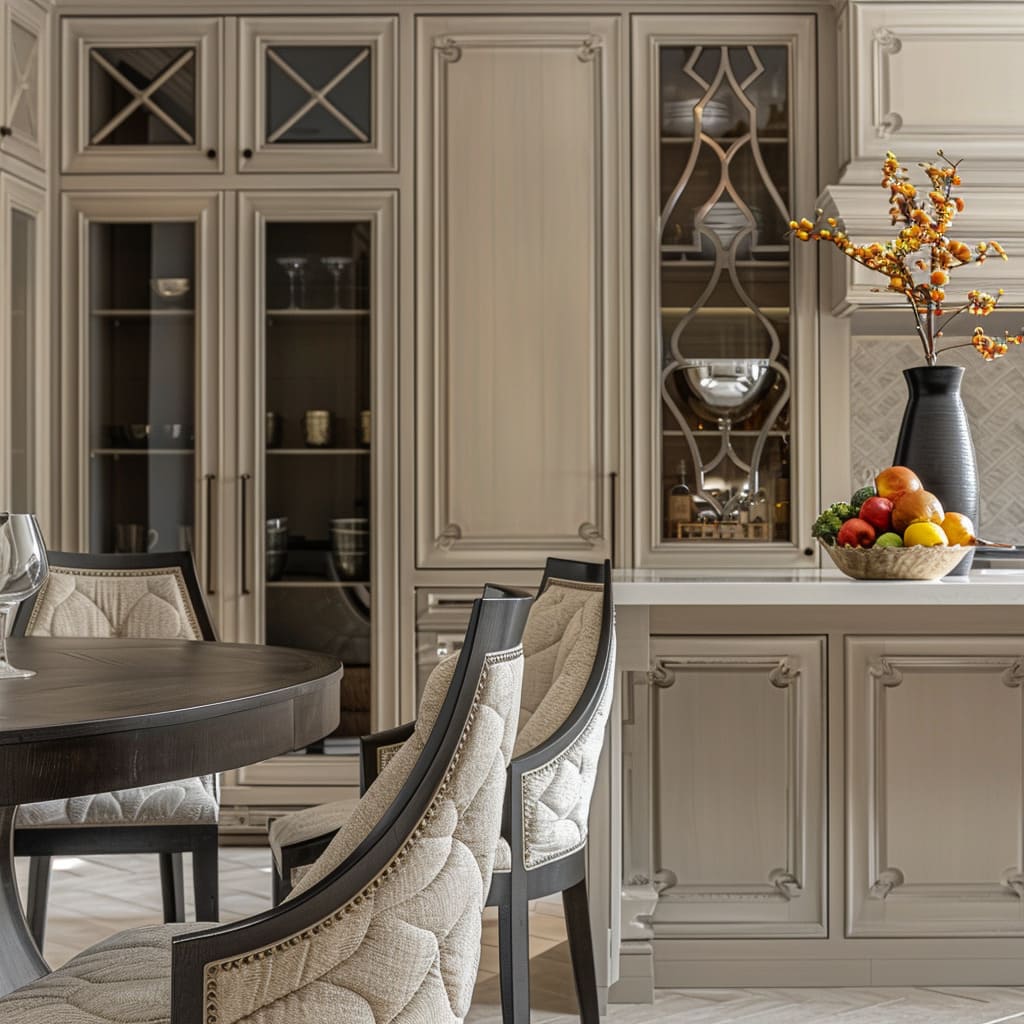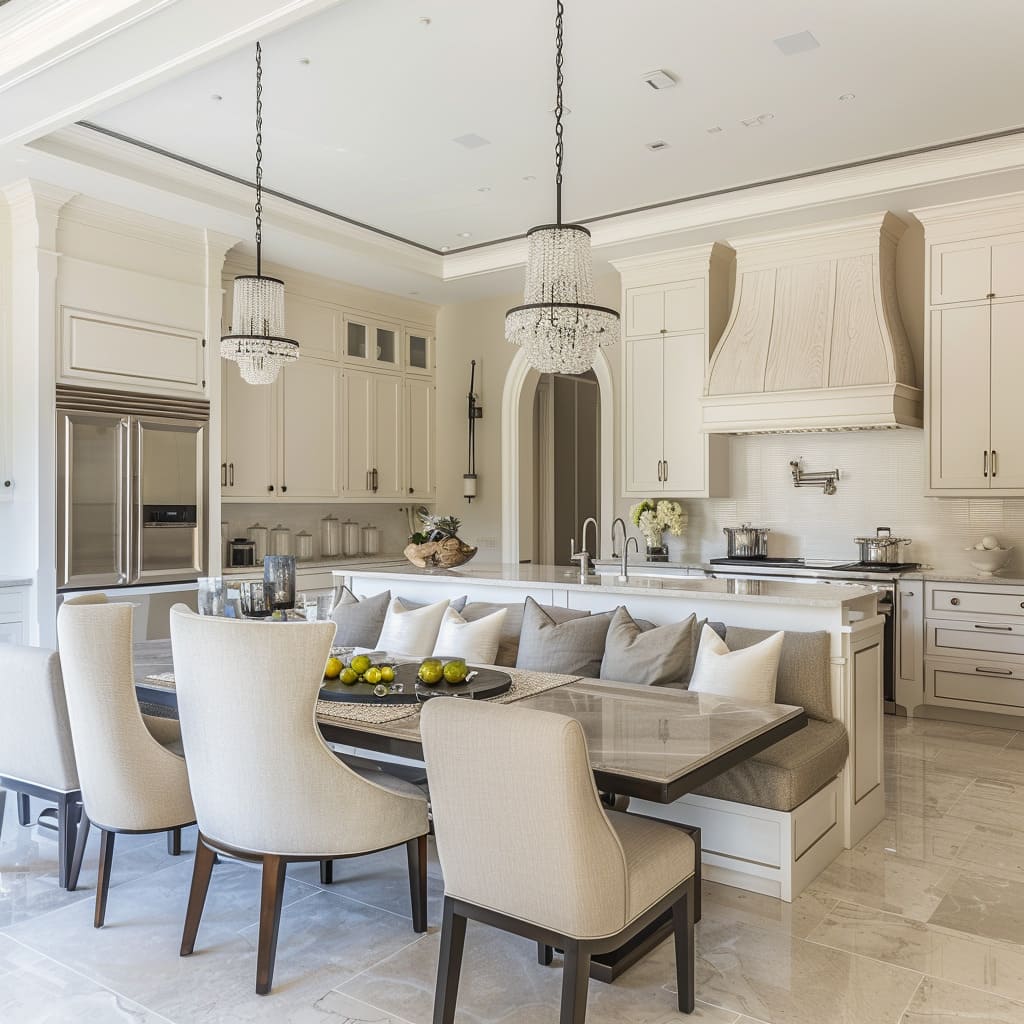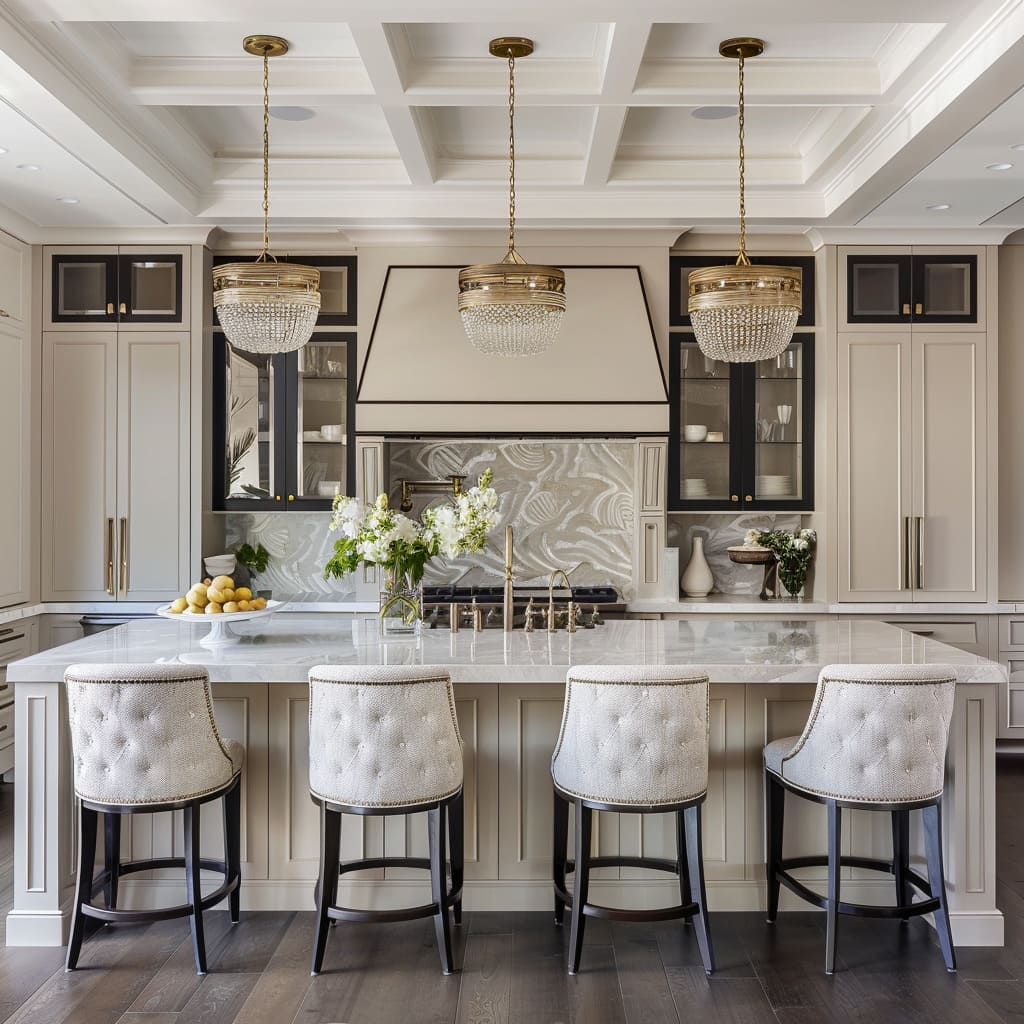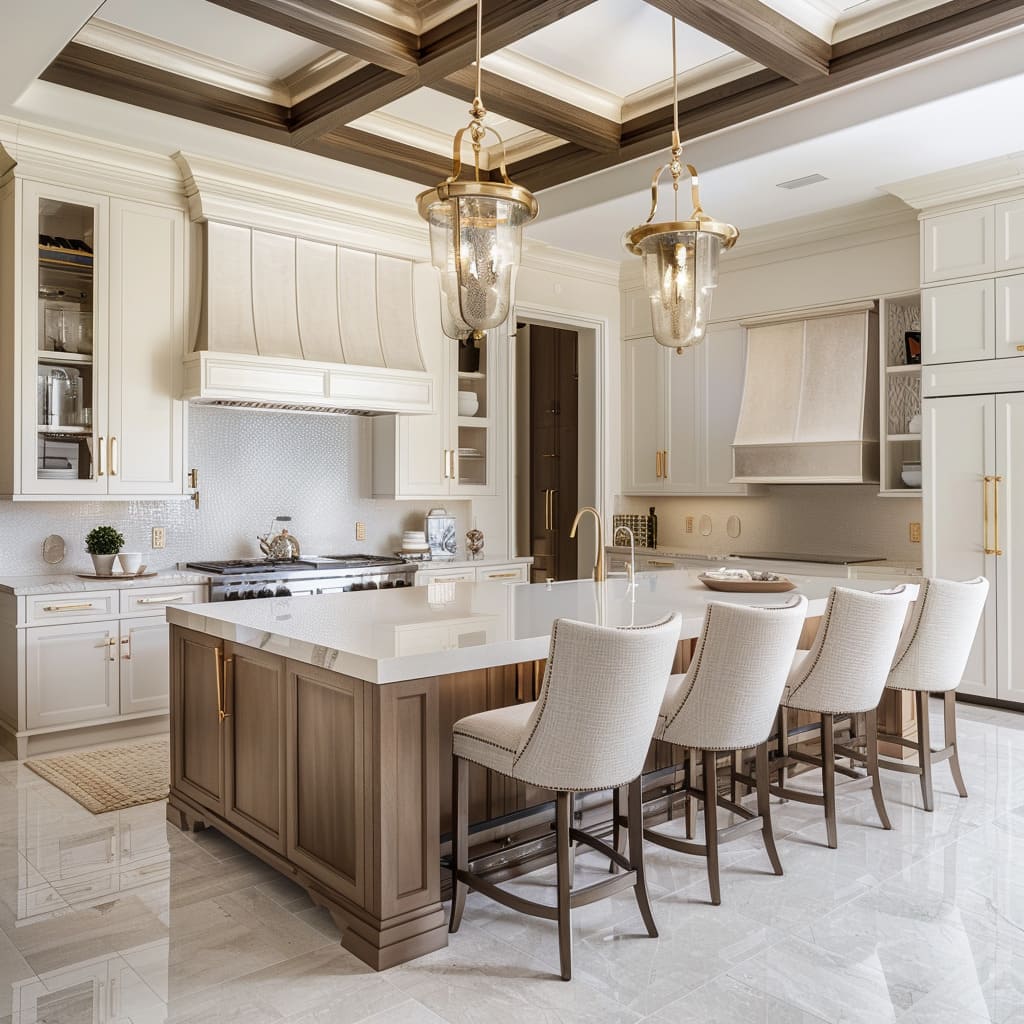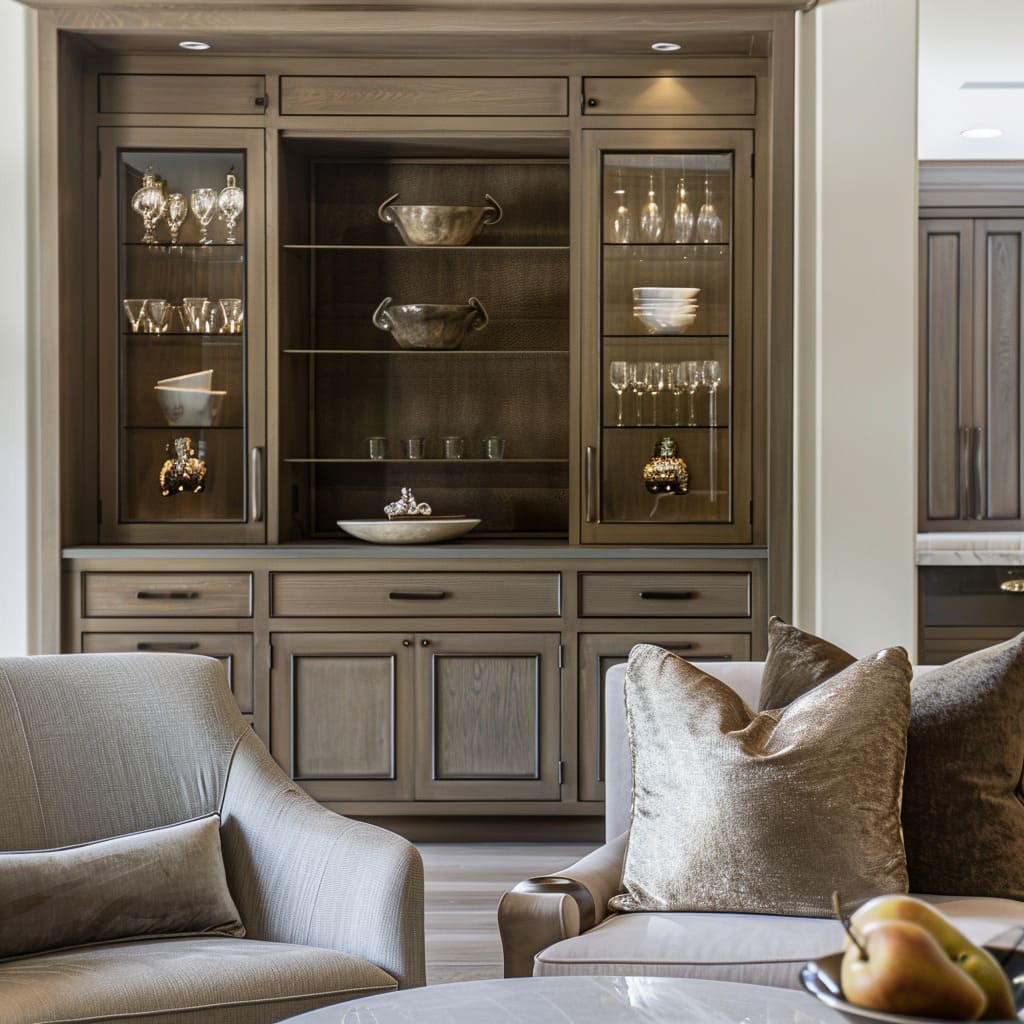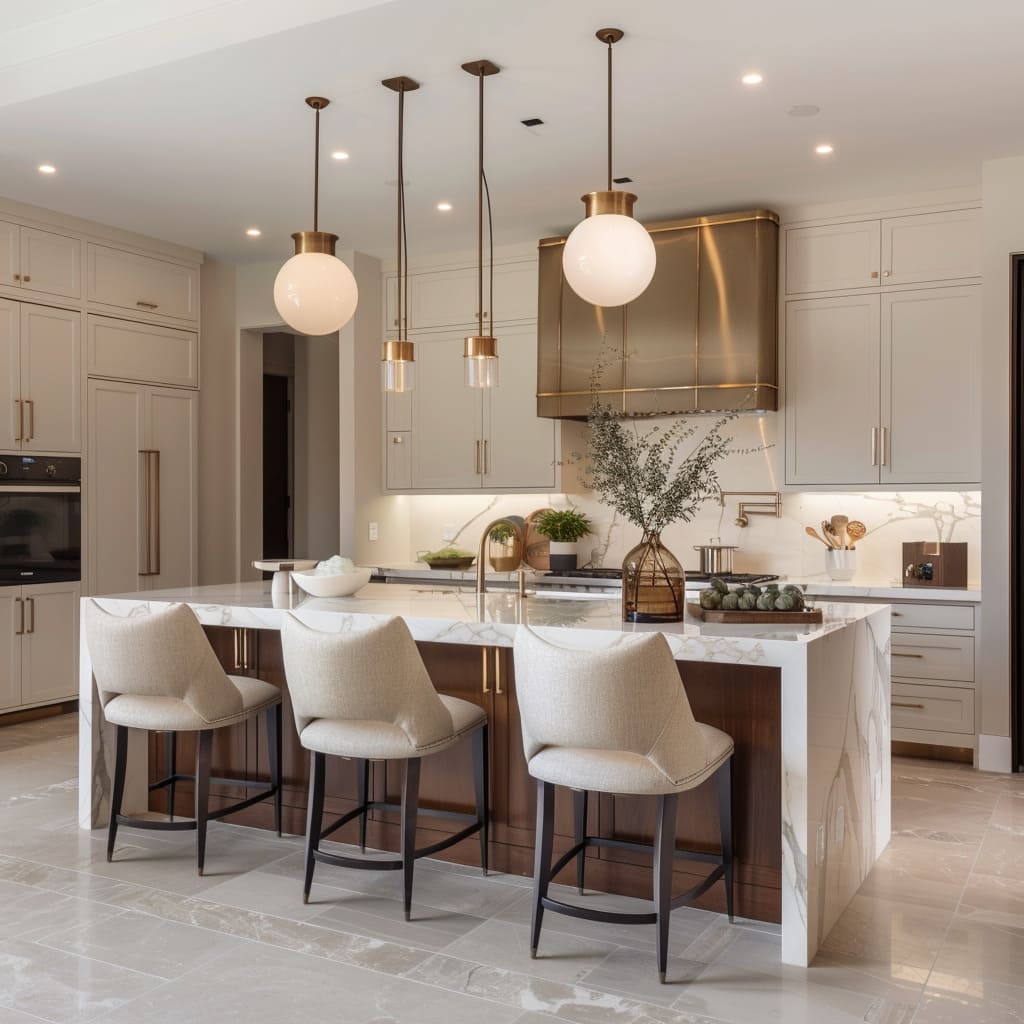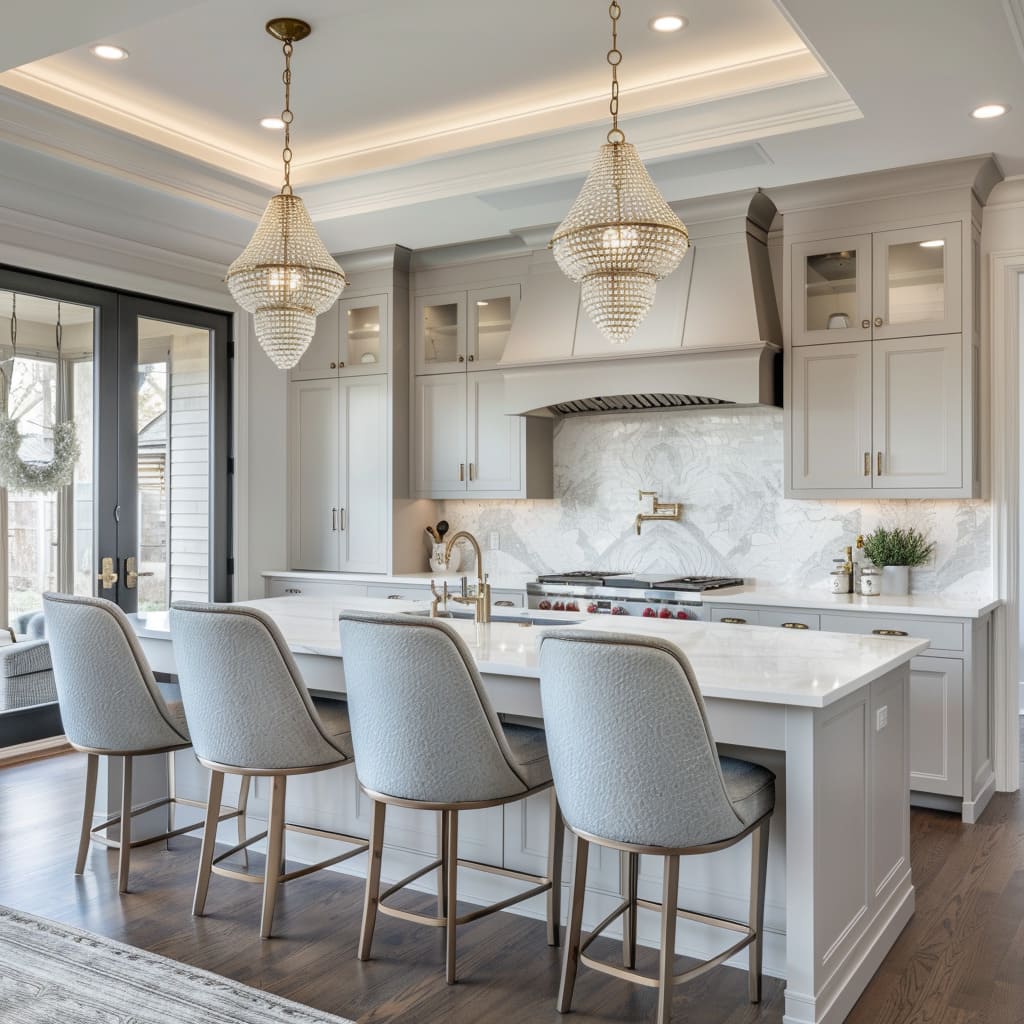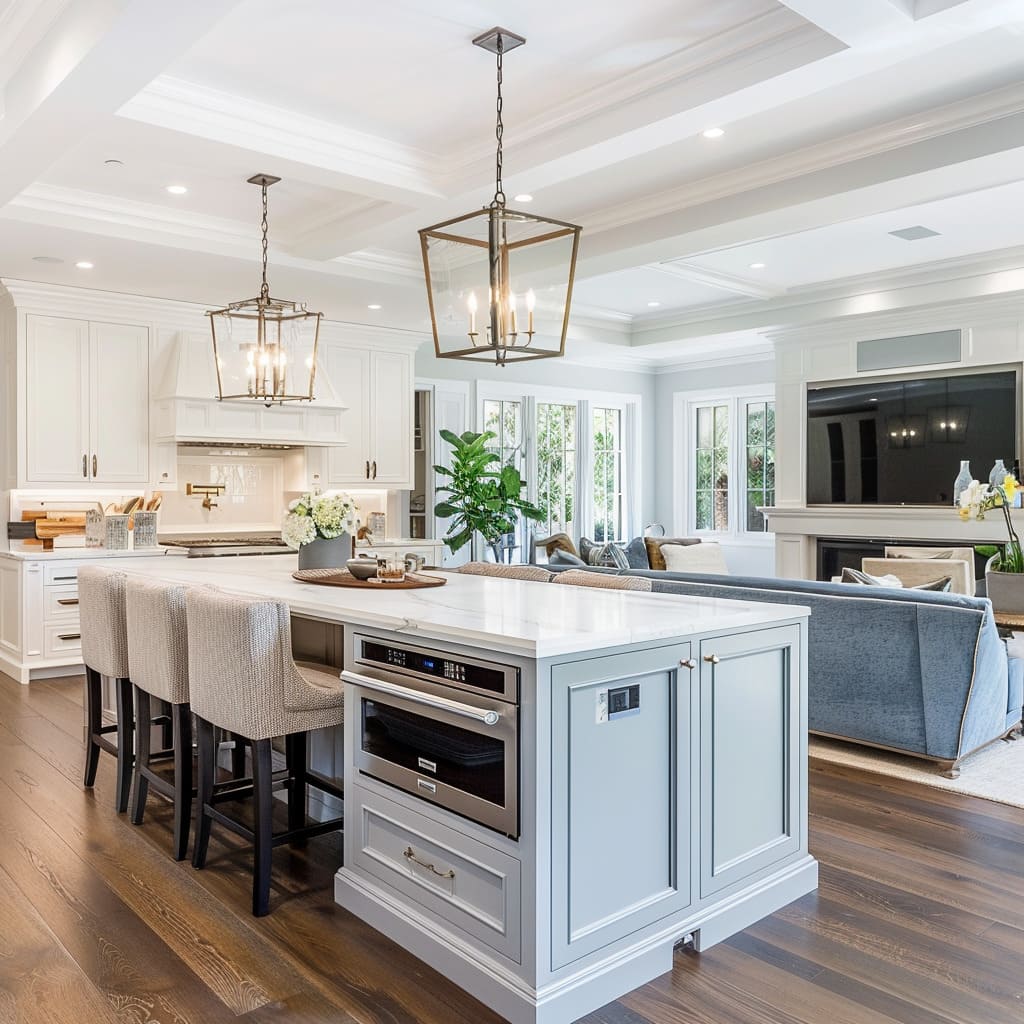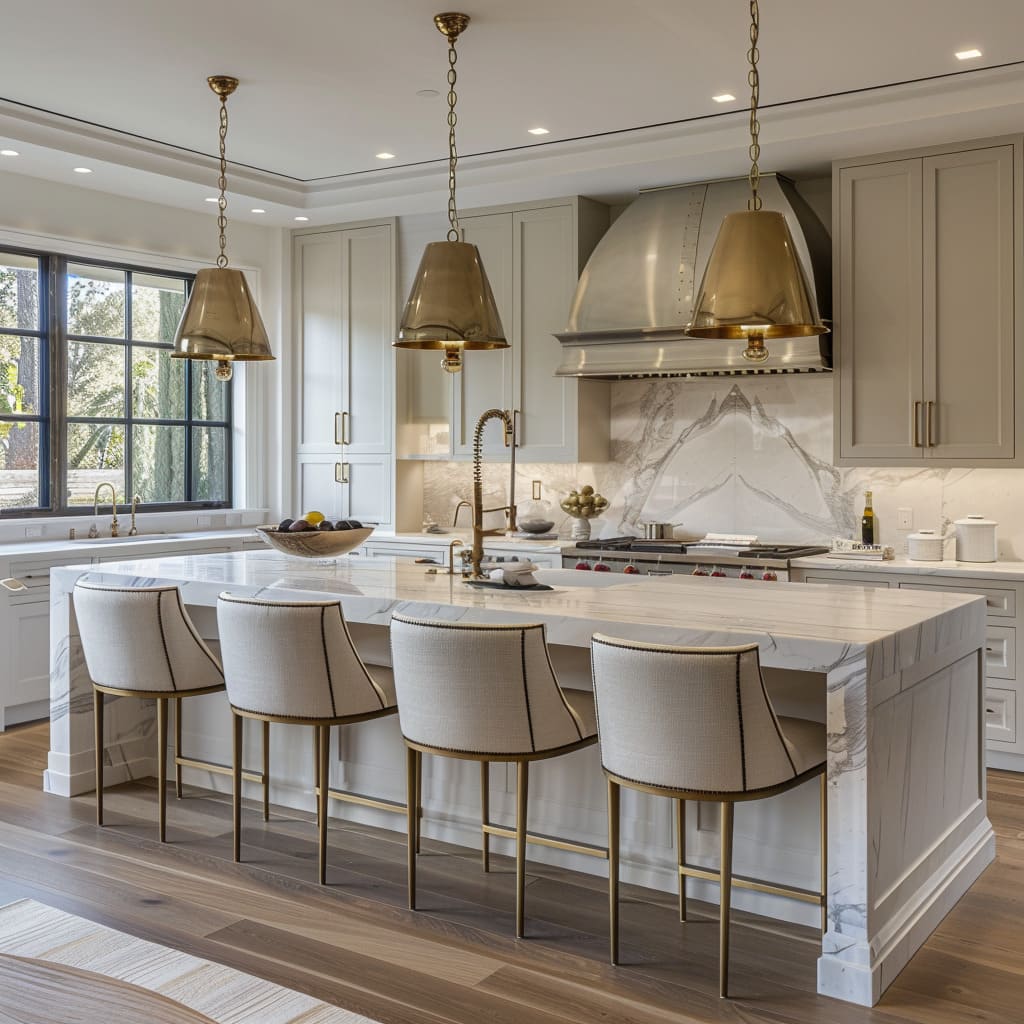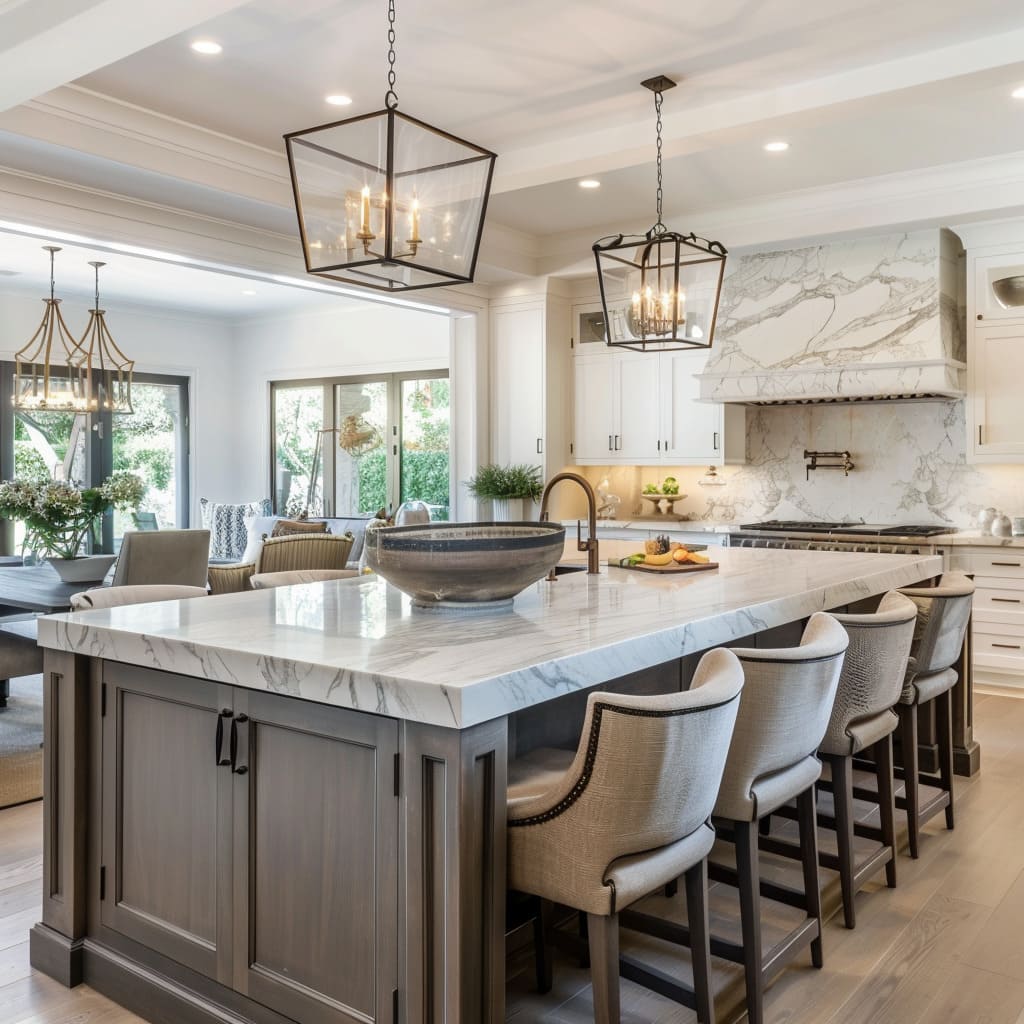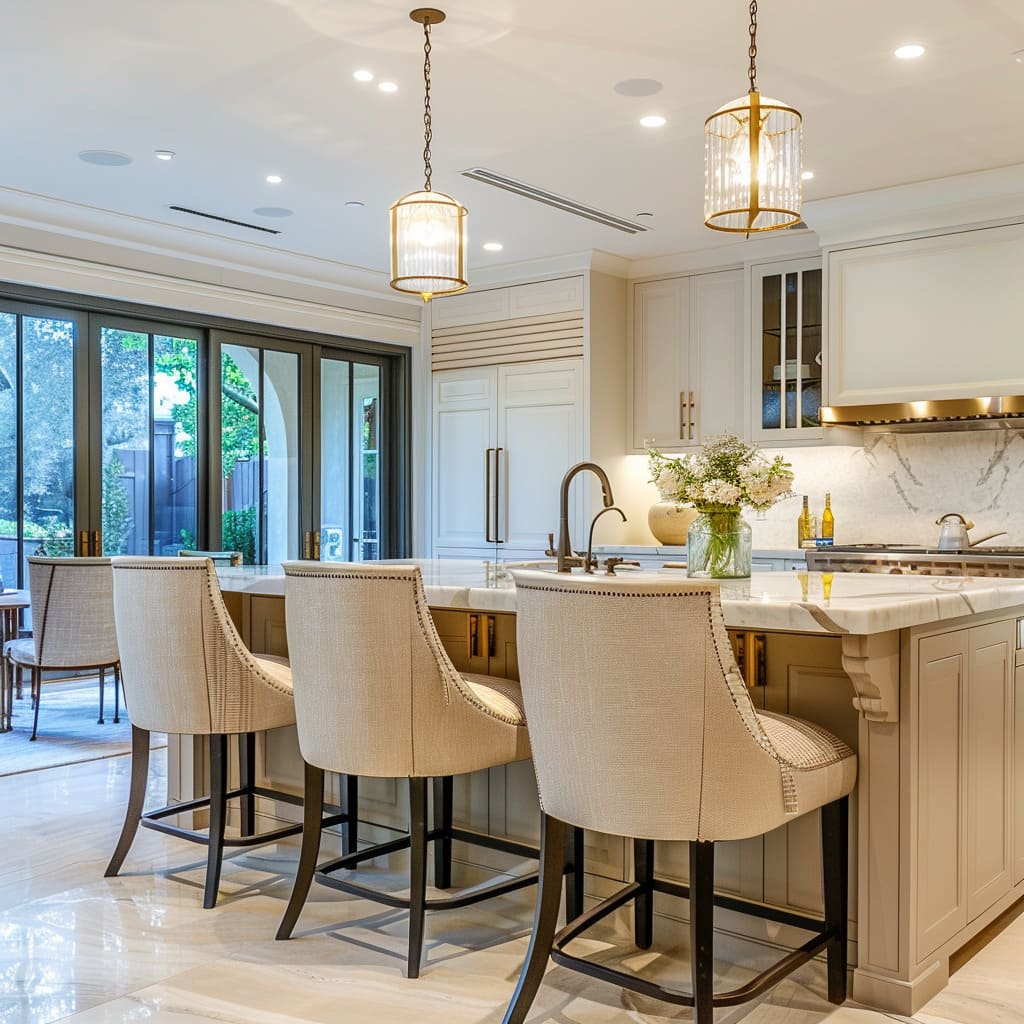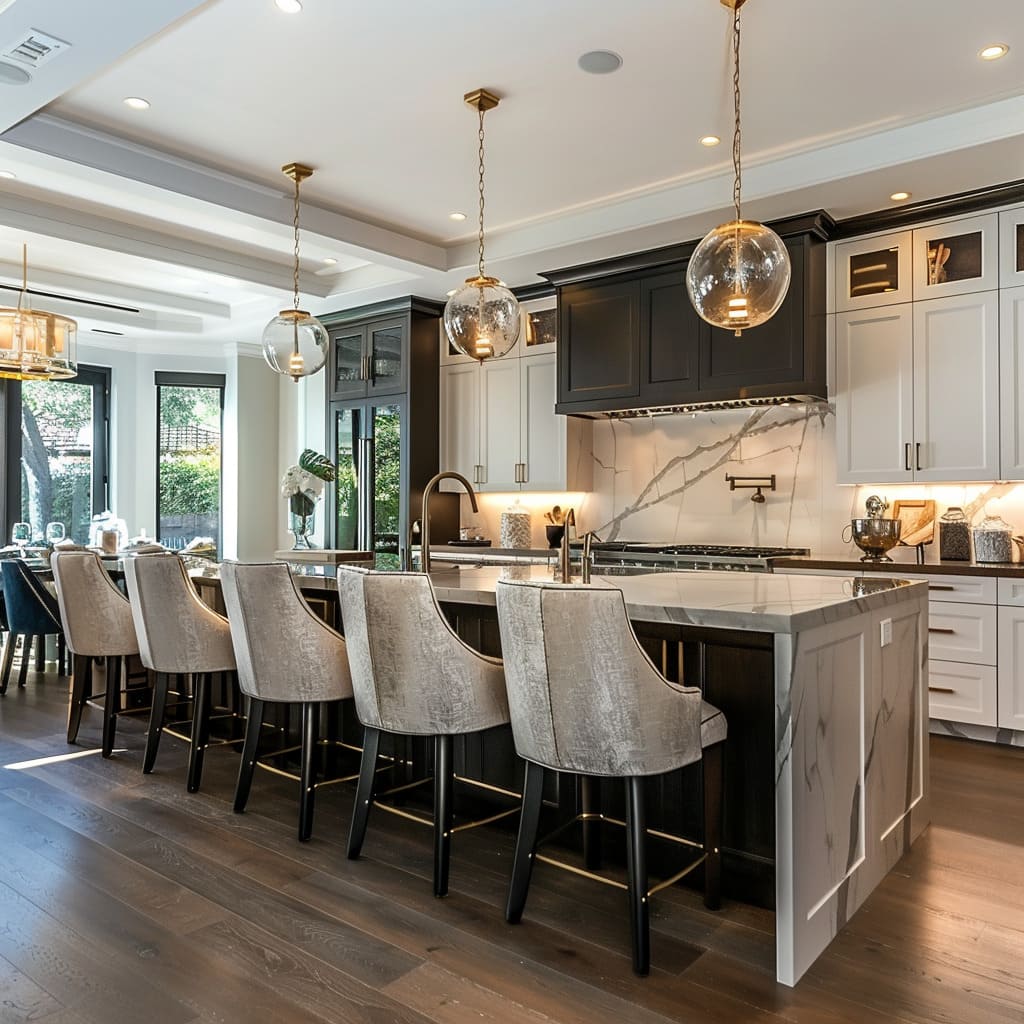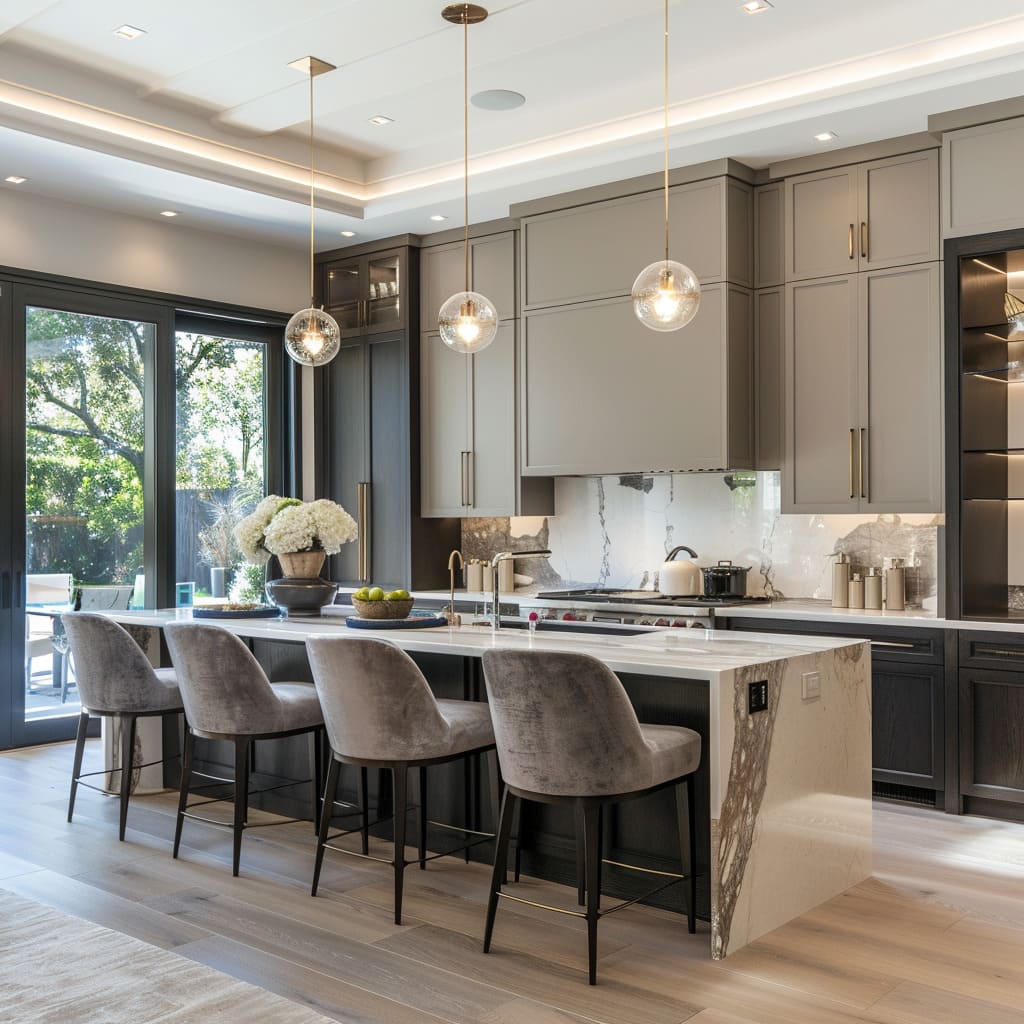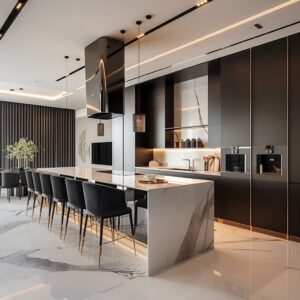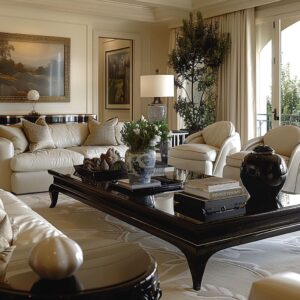Transitional style kitchens have become increasingly popular in recent years, striking a balance between traditional charm and modern sleekness. This design approach creates a harmonious and timeless space that appeals to a wide range of tastes.
Combining elements from both ends of the design spectrum, transitional kitchens offer versatility, making them a favored choice for homeowners looking to blend the old with the new.
Key Elements of Transitional Style Kitchens
Cabinetry and Storage
The cabinetry in a transitional style kitchen is a cornerstone of its design, reflecting a blend of classic and contemporary influences. Upper cabinets often feature a soft, muted grey or white finish with clean lines, maintaining a sophisticated look without being overly ornate.
The simplicity of the flat panel doors, paired with minimalistic gold handles, exemplifies the transitional ethos of combining understated elegance with modern minimalism.
Lower cabinets and island bases typically adopt a darker wood stain, adding depth and contrast. This darker hue not only grounds the kitchen visually but also provides a warm, inviting feel.
Glass-front cabinets are strategically placed to display elegant dishware and glassware, enhancing the aesthetic without overwhelming the space. The use of glass allows for a sense of openness and airiness, breaking up the solidity of the cabinetry.
Storage is maximized by extending cabinets to the ceiling, ensuring ample space for kitchen essentials. The clever integration of modern conveniences like pull-out shelves and deep drawers ensures functionality while maintaining a streamlined appearance.
This thoughtful approach to storage is essential in a transitional kitchen, where efficiency meets style.
Countertops and Islands
The choice of countertops in a transitional kitchen is crucial for achieving the desired balance between classic and contemporary. Light-colored marble or quartz with subtle veining is a popular choice, adding a touch of luxury without appearing ostentatious.
These materials provide a clean, polished surface that enhances the kitchen’s overall brightness and elegance.
The central island is a focal point in the kitchen, serving multiple purposes. It offers additional workspace, storage, and seating, making it a versatile hub for both food preparation and casual dining.
The island often features a waterfall edge, showcasing the beauty of the marble or quartz.
A built-in sink with a sleek, brushed gold faucet adds an element of sophistication, while the inclusion of comfortable barstools ensures the island is a welcoming place for family and friends to gather.
Backsplash and Range Hood
The backsplash in a transitional kitchen is more than just a functional element; it is a key design feature that ties the room together. Using the same marble or quartz as the countertops creates a seamless look that is both cohesive and visually appealing.
The subtle veining in the stone adds texture and interest, complementing the overall design without dominating it.
The range hood, integrated into the cabinetry, maintains the kitchen’s clean lines. Painted to match the upper cabinets, it blends seamlessly into the background, allowing the backsplash to take center stage.
This approach ensures that the range hood is both functional and aesthetically pleasing, aligning with the transitional style’s emphasis on understated elegance.
Appliances
High-end stainless steel appliances are a hallmark of transitional kitchens, offering both style and functionality. These appliances are often integrated into the cabinetry to maintain a streamlined appearance.
The refrigerator, for instance, is concealed behind matching cabinet panels, ensuring it blends in seamlessly with the surrounding cabinetry.
The cooktop, usually located on the island, allows for easy meal preparation and interaction with guests. Paired with a sleek, modern range hood, it provides efficient ventilation while maintaining the kitchen’s cohesive look.
Built-in ovens and microwaves are strategically placed for convenience, ensuring the kitchen is as practical as it is beautiful.
Lighting
Lighting plays a crucial role in enhancing the ambiance and functionality of a transitional kitchen. A combination of natural light and thoughtfully placed artificial lighting creates a warm and inviting atmosphere.
Pendant lights with gold accents and clear glass globes are often used above the island, providing focused task lighting and adding a touch of glamour. These lights create a striking focal point, illuminating the workspace and enhancing the kitchen’s overall brightness.
Recessed lighting is strategically placed throughout the kitchen to ensure even illumination, highlighting key areas and providing ample light for cooking and dining. Under-cabinet lighting adds another layer of functionality, illuminating the countertops and showcasing the beauty of the backsplash.
Flooring
The flooring in a transitional kitchen is typically made of wide-plank light wood, adding warmth and texture to the space. The natural grain and light finish of the wood contrast beautifully with the darker cabinetry, creating a balanced and harmonious look.
This choice of flooring not only complements the overall aesthetic but also provides a durable and practical surface for a busy kitchen.
If you’re considering transforming your kitchen into a beautiful and functional space, you might be curious about the potential cost of redoing a kitchen. To get an approximate estimate tailored to your needs, try our easy-to-use kitchen cost calculator.
What’s the Best You Can Get with Your Budget?
Enter your budget details and discover the full range of options available to you!
[budget_renovation_calculator]
Seating and Dining Areas
The design of seating and dining areas in a transitional kitchen is both stylish and functional. The island often includes built-in seating, with plush barstools that offer comfort and elegance.
Upholstered in soft grey velvet fabric, these barstools feature curved backs and gold footrests, echoing the gold accents used throughout the kitchen.
A banquette seating area, nestled into a cozy nook, provides a more intimate dining option. The built-in bench, upholstered in a light fabric with dark trim, is adorned with a mix of cushions and pillows in complementary shades.
This arrangement creates a comfortable and inviting space for casual dining or relaxing with a cup of coffee. The round dining table, with its light-colored top and gold trim, ties in with the kitchen’s overall design, offering a stylish and practical spot for meals.
Decor and Accessories
The decor in a transitional kitchen is minimalistic yet impactful, with carefully chosen pieces that enhance the overall design. A large vase with fresh flowers, such as hydrangeas or orchids, adds a touch of nature and a pop of color.
These floral arrangements complement the neutral color palette and bring a sense of freshness to the space.
A decorative bowl filled with fresh fruit, like green apples, adds a vibrant and healthy element to the countertop. Practical items, such as a knife block, spice jars, and a cutting board, are neatly arranged on the countertops, adding functionality without cluttering the space.
Open shelving near the cooking area displays decorative items and frequently used kitchenware, combining style and practicality.
If you’re inspired by the charm of farmhouse style and would like to see more kitchen design ideas, check out our detailed guide on modern farmhouse kitchen interiors. Visit Elements of Modern Farmhouse Kitchen Interiors for inspiration and tips.
<>Layout and Functionality
The open plan design of a transitional kitchen allows for easy movement and interaction between different areas. This layout is ideal for both everyday living and entertaining, ensuring the kitchen is as practical as it is beautiful.
Open Plan Design
An open layout enhances the kitchen’s sense of space and light, creating a seamless transition between the cooking, dining, and living areas. This design approach encourages social interaction, making it easy for family members and guests to engage with one another while meals are being prepared.
Efficient Use of Space
The efficient use of space is a key consideration in transitional kitchens. The layout is designed to ensure easy movement and access to all areas, with ample workspace and storage.
This practical approach ensures the kitchen remains functional and organized, even during busy meal preparation times.
Connection to Outdoor Spaces
Large glass doors and windows are often used to create a connection between the indoor kitchen and outdoor spaces. This integration allows for a seamless transition between the two areas, enhancing the sense of openness and bringing in natural light.
The views of the greenery outside further enhance the kitchen’s bright and airy feel, making it a pleasant place to cook and dine.
For those seeking ideas tailored to smaller spaces, check out our comprehensive guide on condo kitchen designs for practical and stylish solutions perfect for compact kitchens.
Balancing Traditional and Modern Elements
Transitional kitchens achieve their distinctive look by balancing traditional and modern elements. This approach creates a space that feels both timeless and contemporary, appealing to a wide range of tastes.
Color Palette
The color palette in a transitional kitchen is typically neutral, with a mix of light and dark tones. This combination creates a balanced and harmonious look that is both calming and visually appealing.
The use of neutral colors allows for flexibility in decor and accessories, making it easy to update the kitchen’s look over time.
Materials and Finishes
A mix of classic and contemporary materials is used to achieve the transitional style. Luxurious materials like marble and quartz are paired with more traditional elements like wood and glass.
The finishes are carefully chosen to complement each other, creating a cohesive and harmonious look. This thoughtful approach to materials and finishes ensures the kitchen is both stylish and durable.
Design Details
Attention to detail is essential in a transitional kitchen. Decorative paneling and moldings add a touch of traditional craftsmanship, while modern features like integrated appliances and sleek lighting fixtures ensure the space remains current.
This combination of classic and contemporary design details creates a kitchen that is both functional and aesthetically pleasing.
Stay ahead of the curve with the latest contemporary kitchen design trends.
Conclusion
In summary, transitional style kitchens offer a perfect blend of traditional charm and modern sophistication. By carefully balancing classic and contemporary elements, these kitchens create a timeless and elegant space that is both beautiful and functional.

